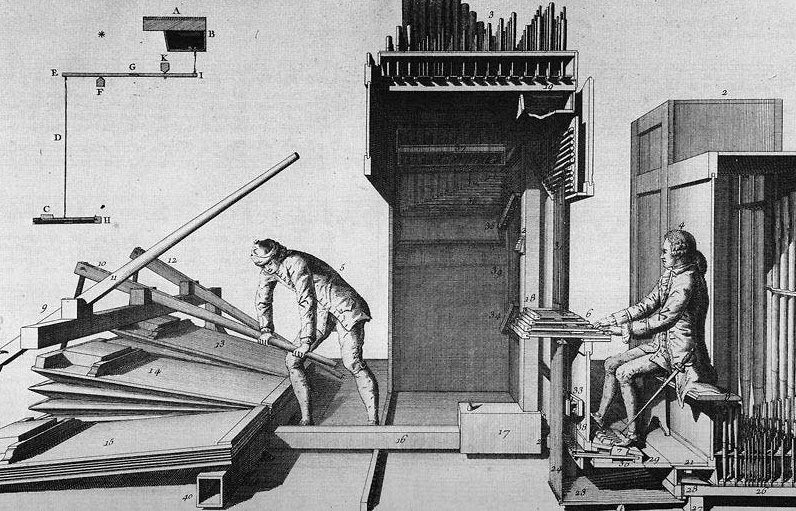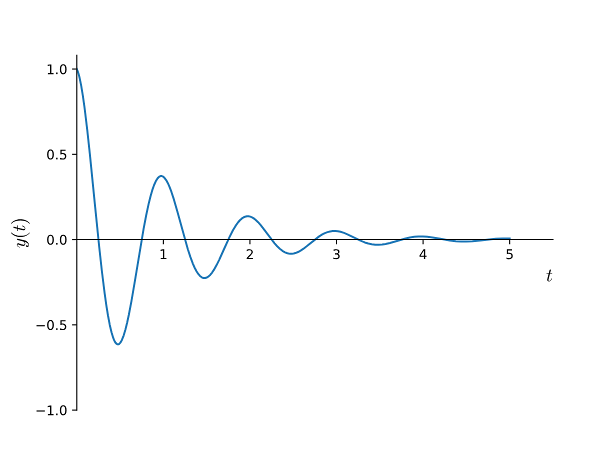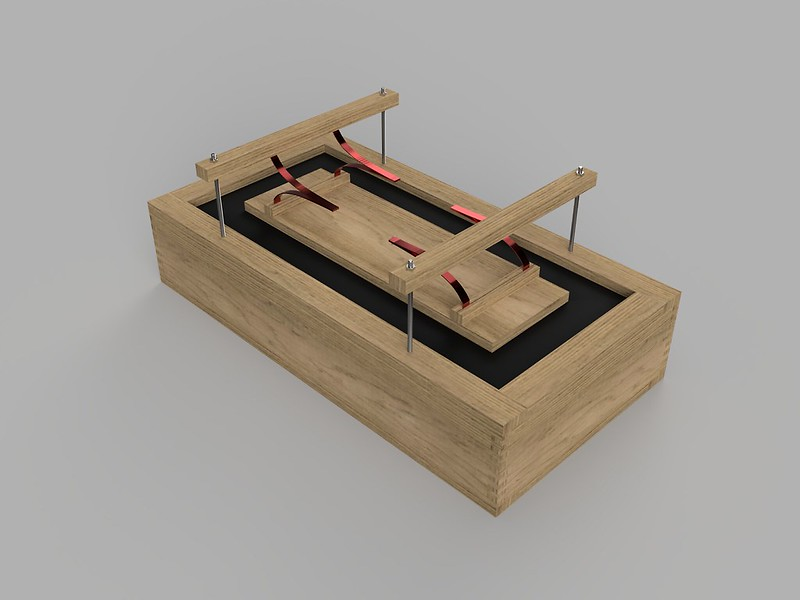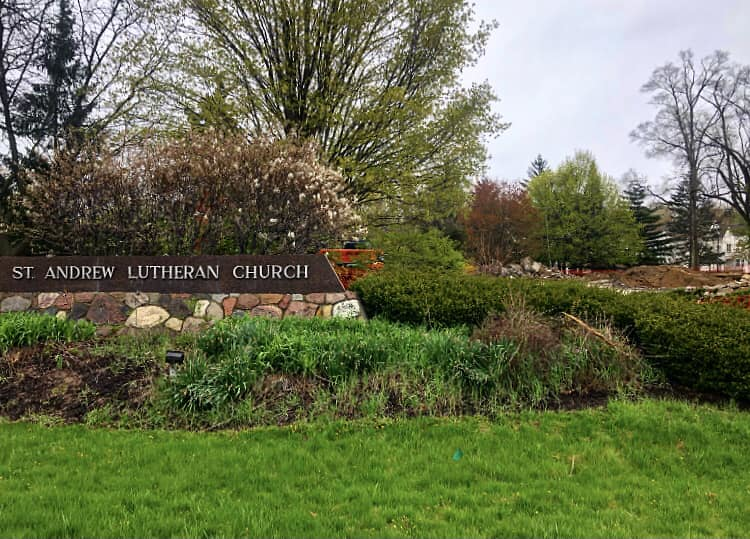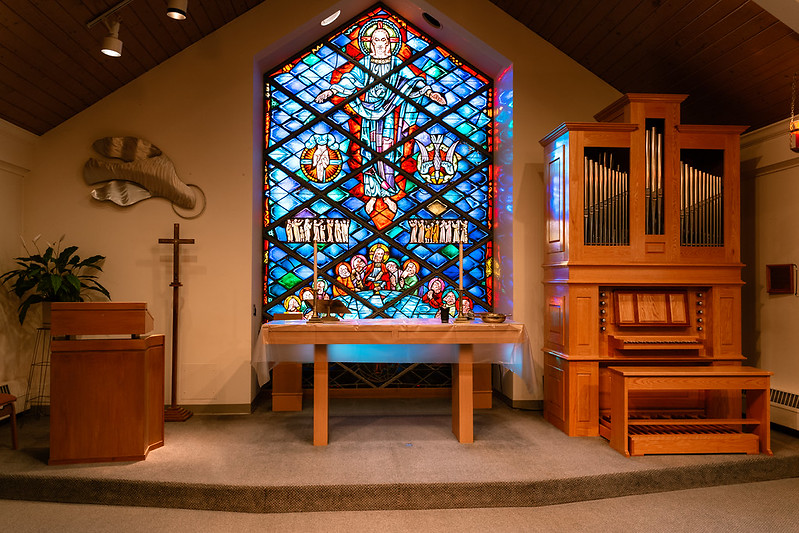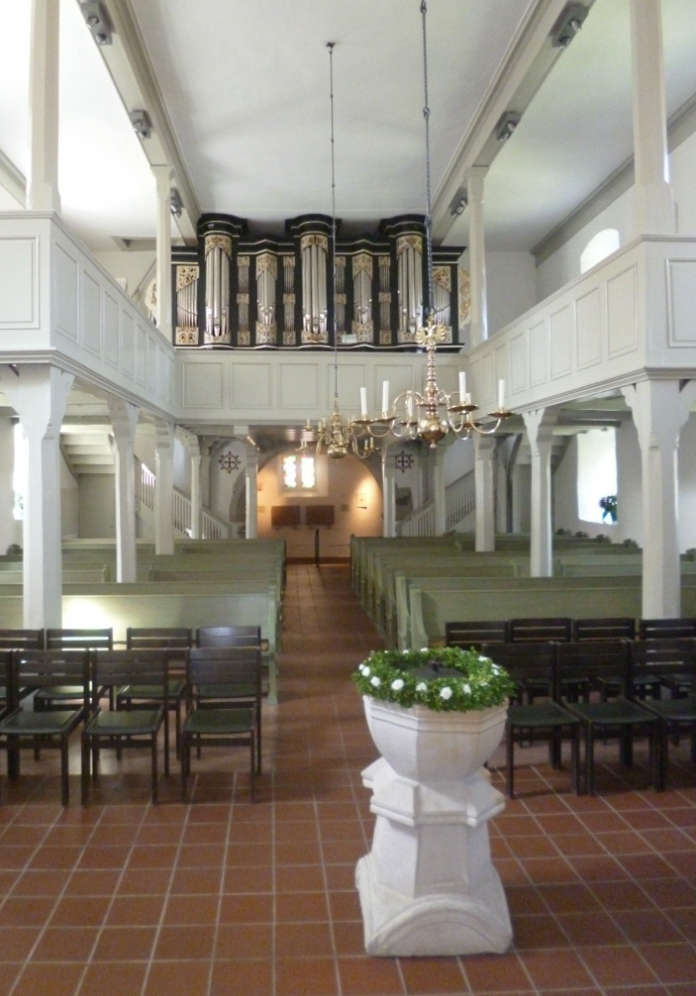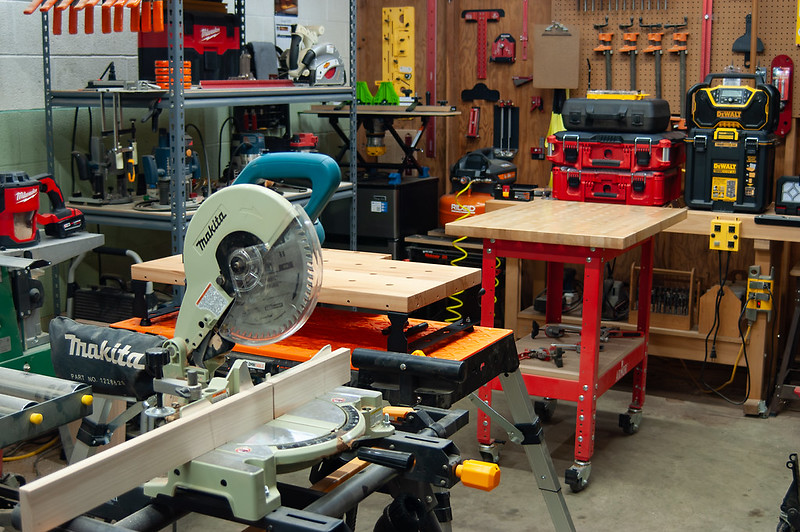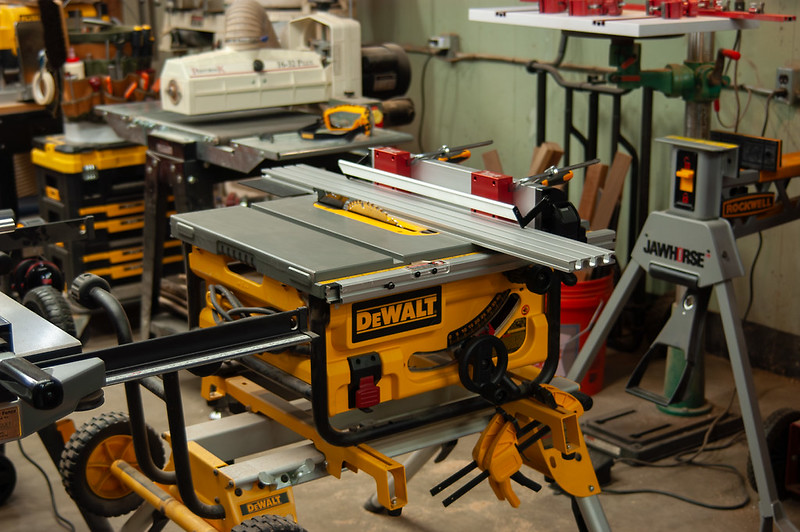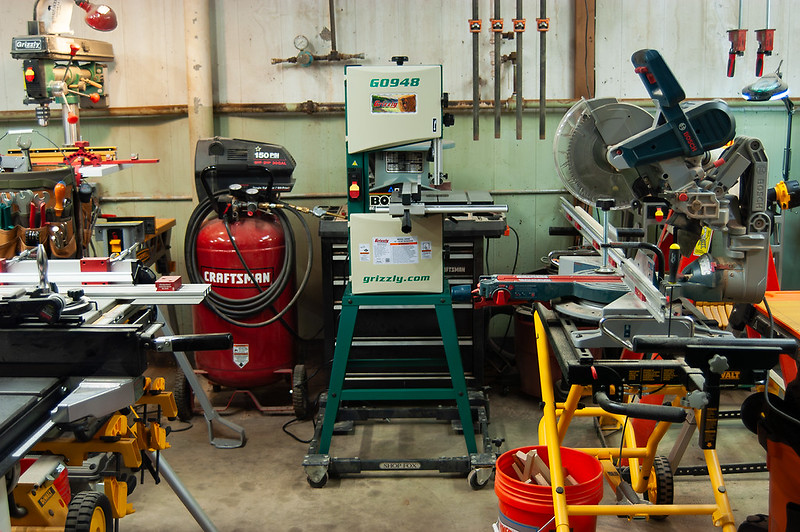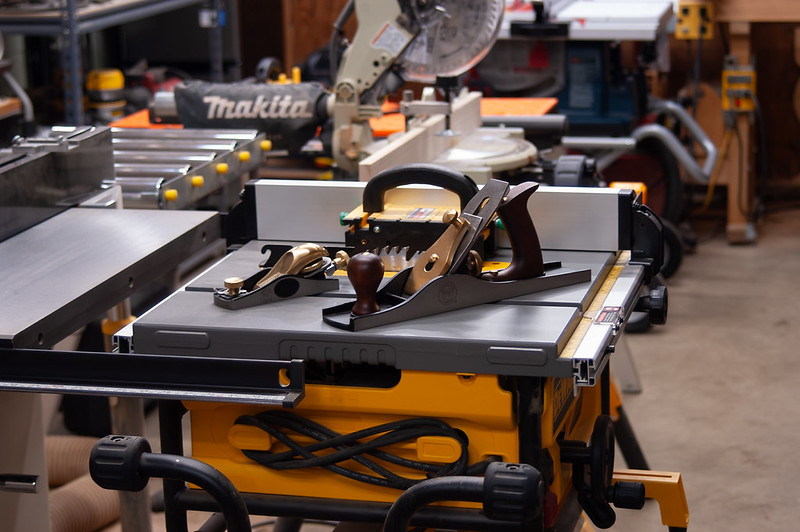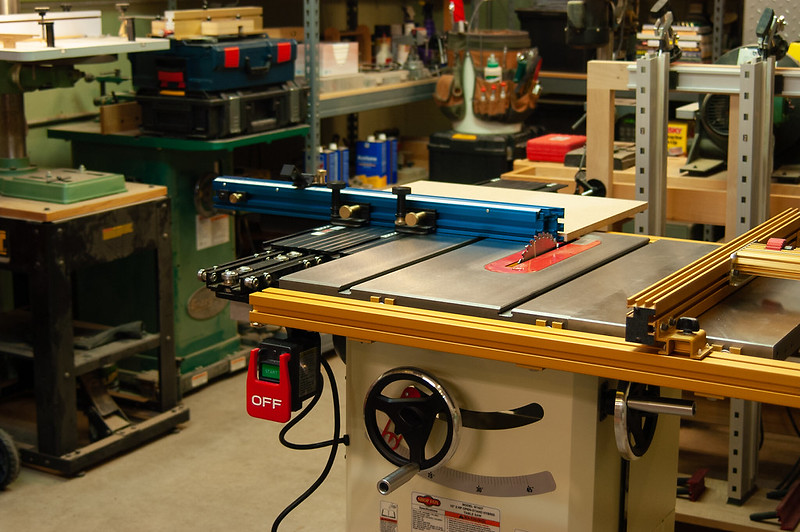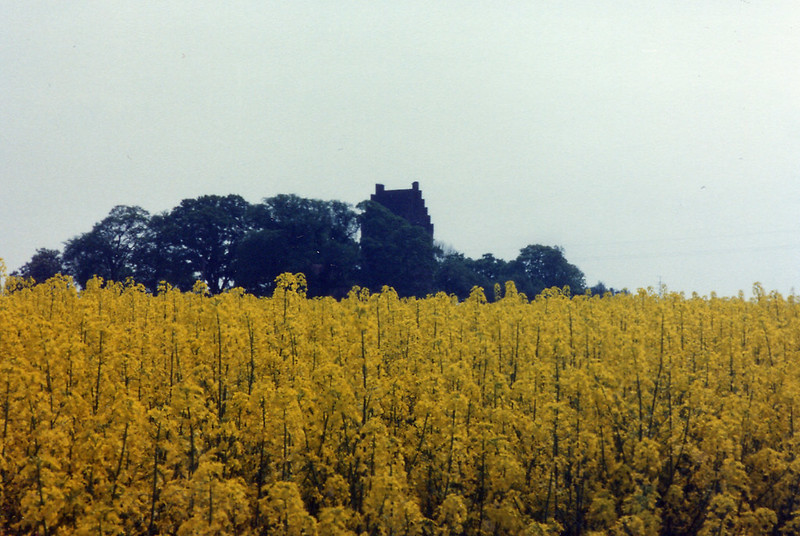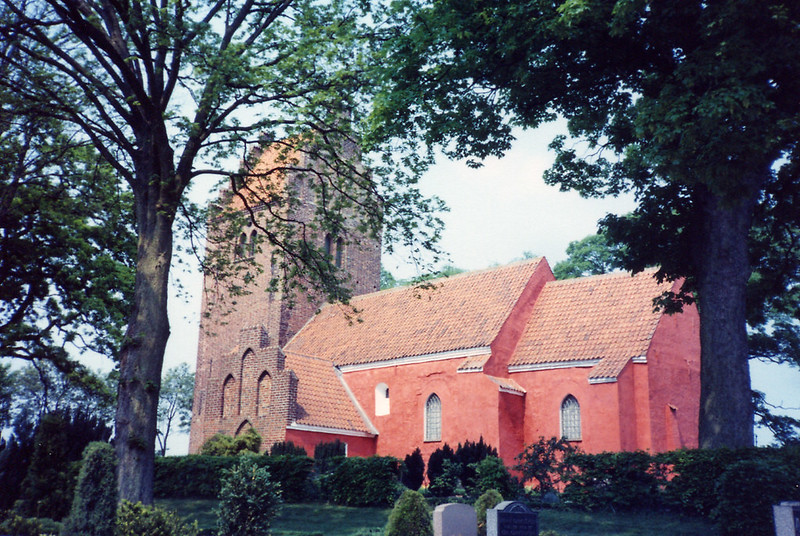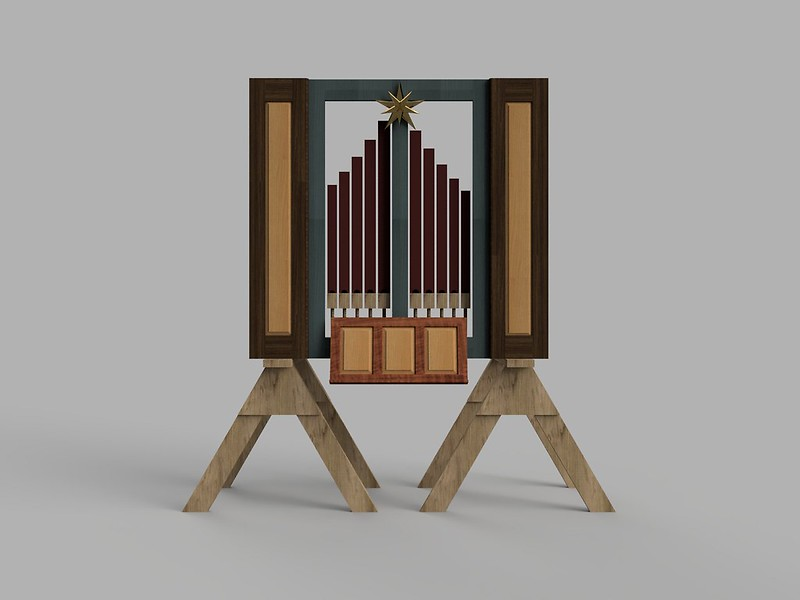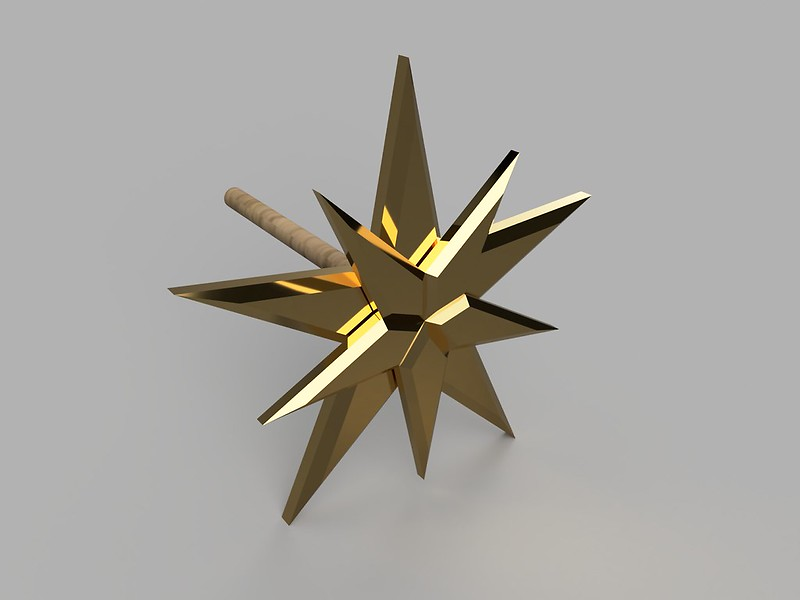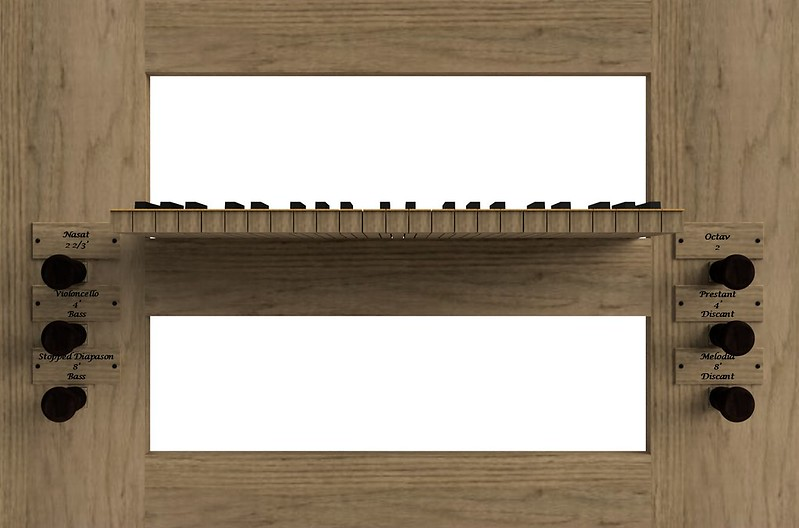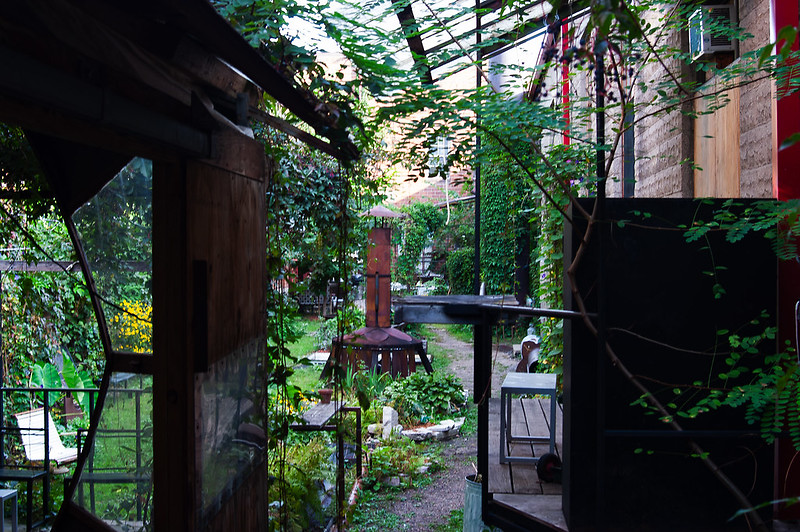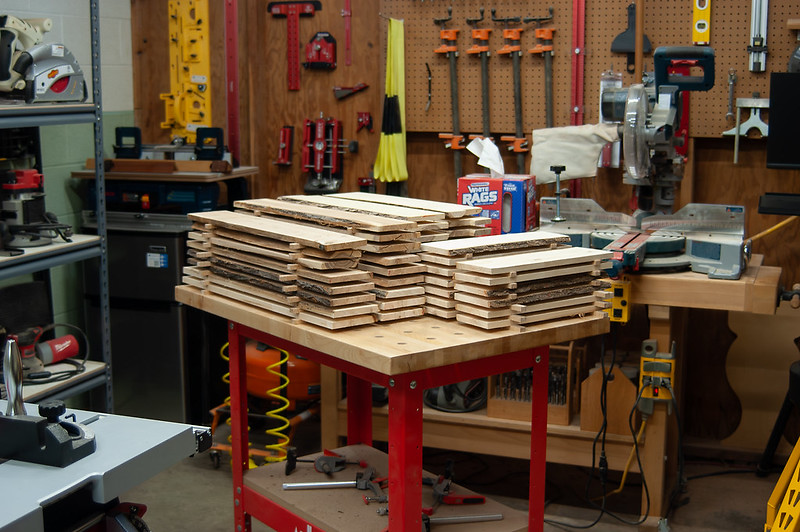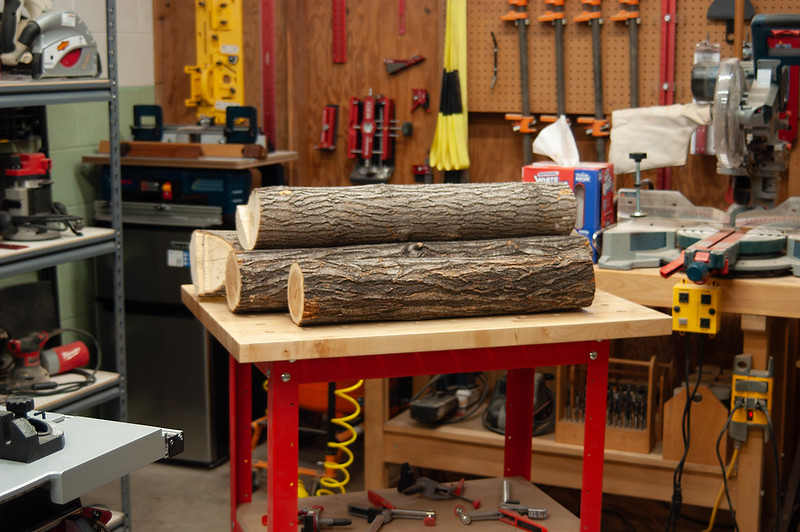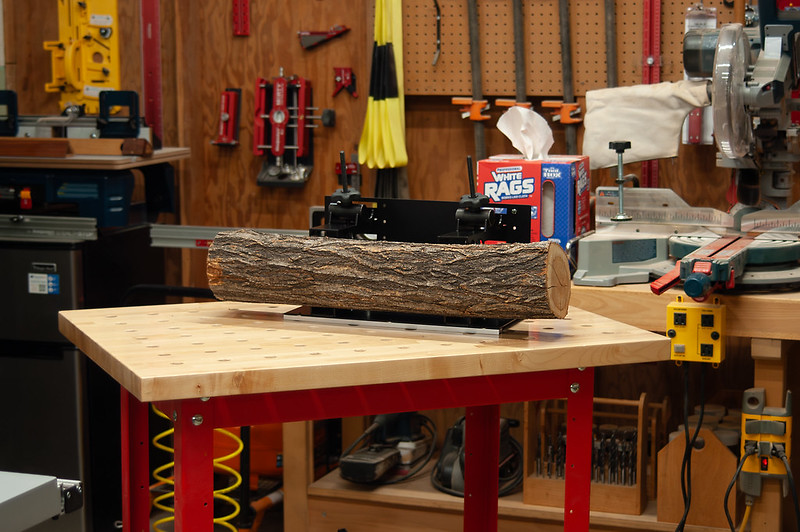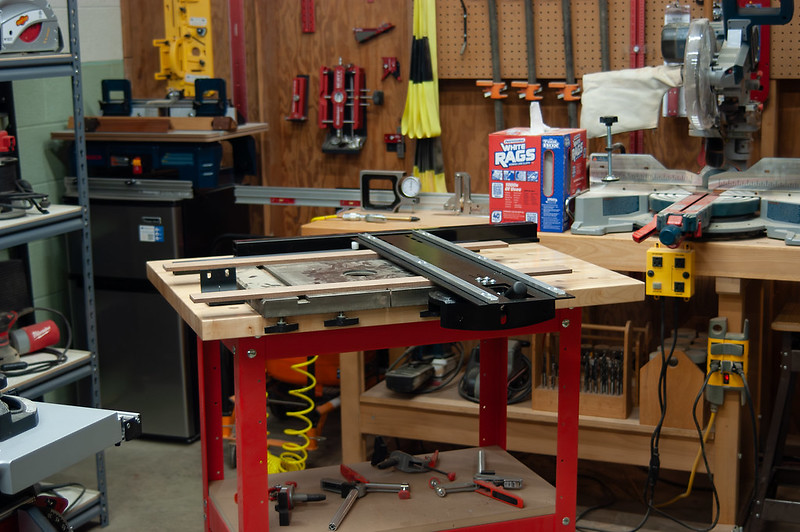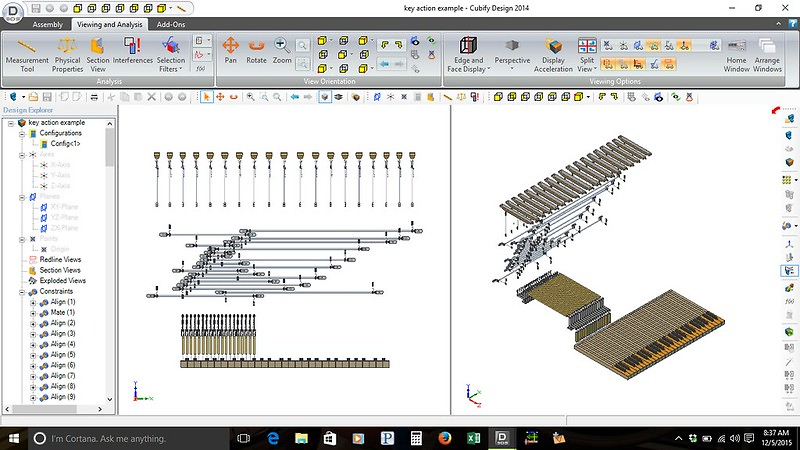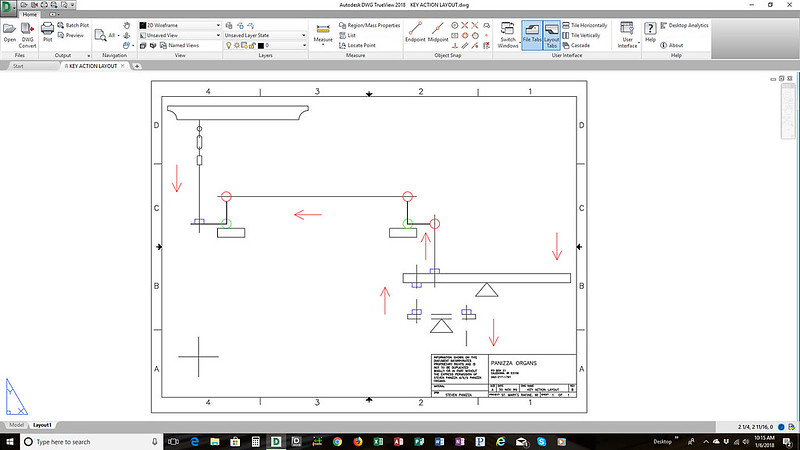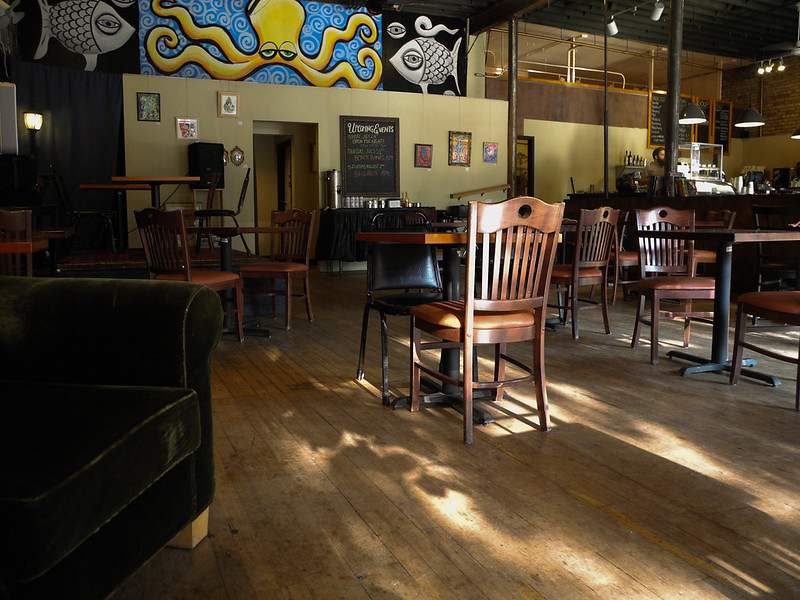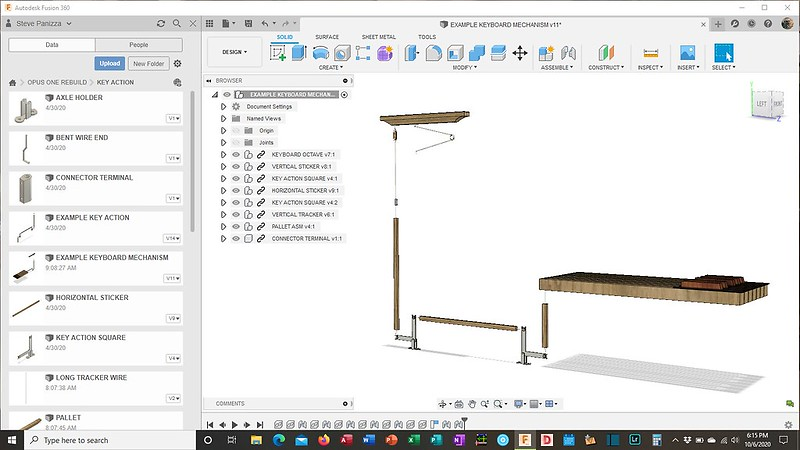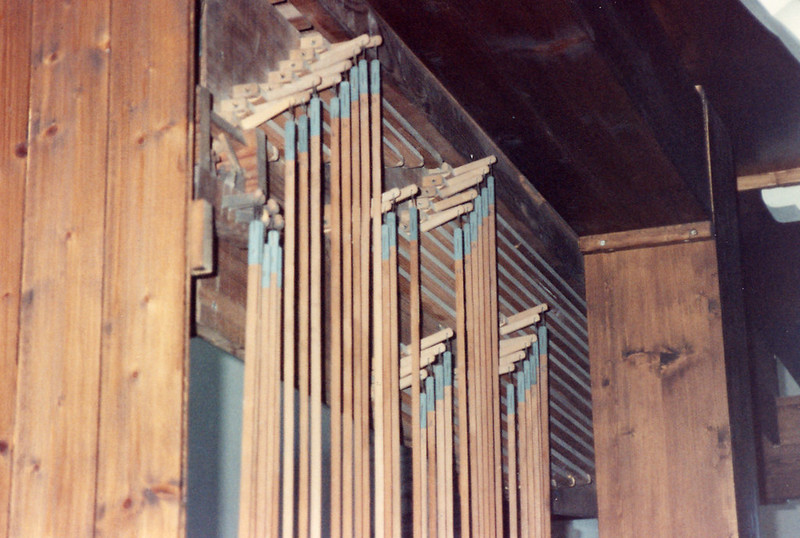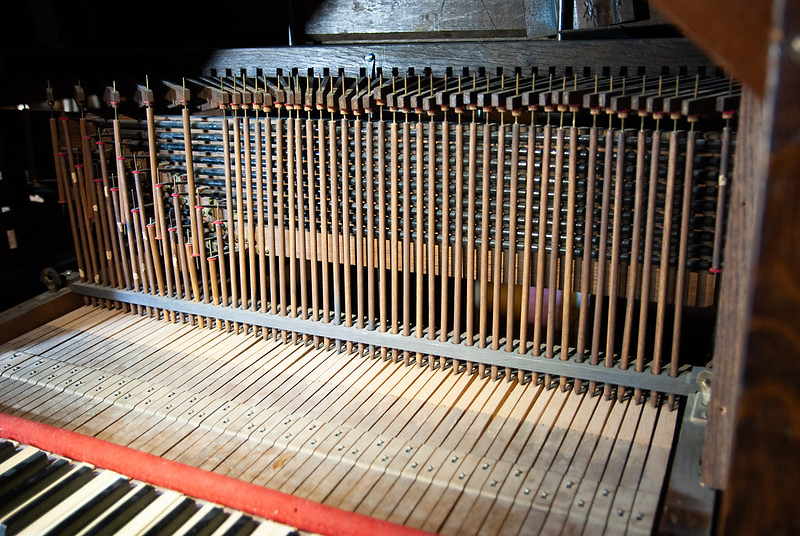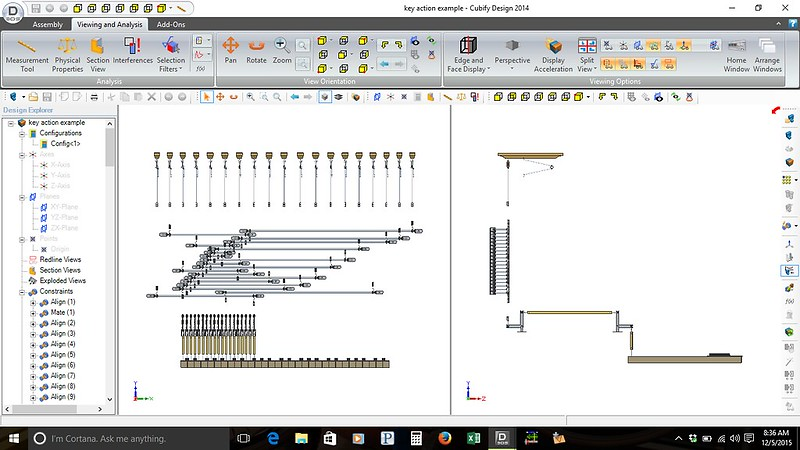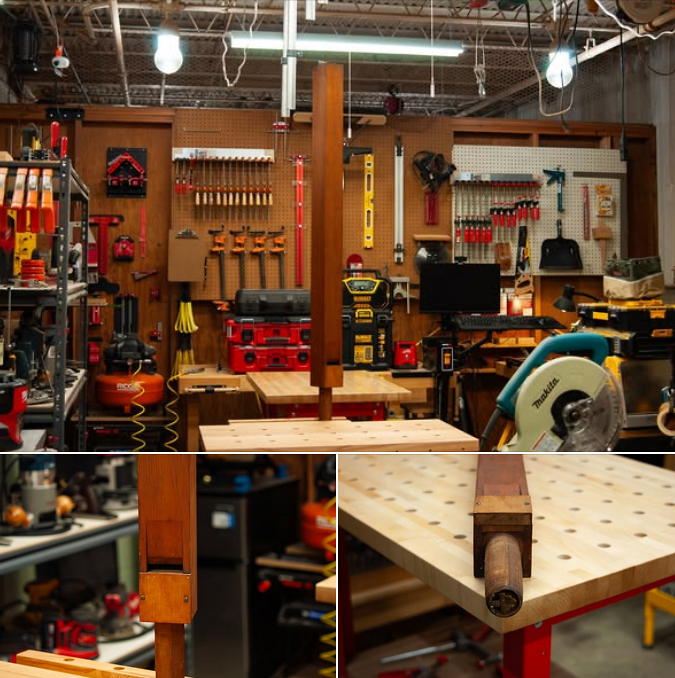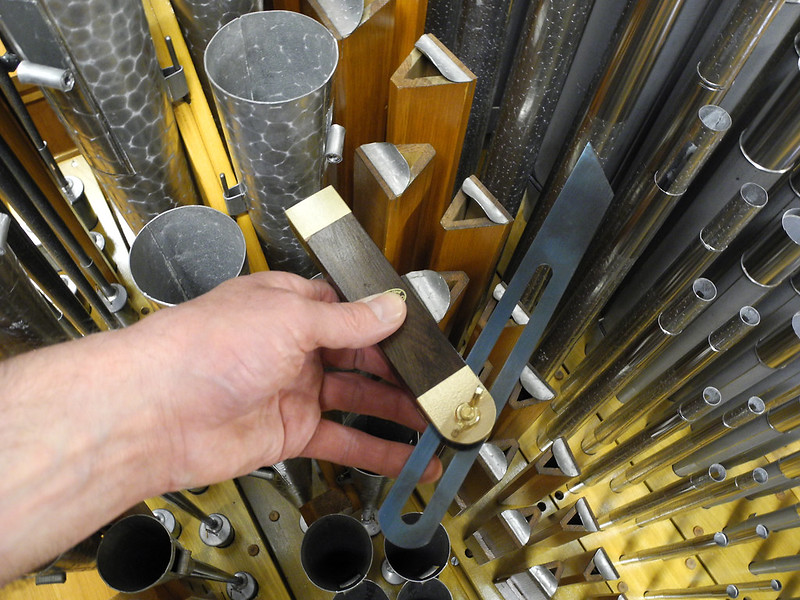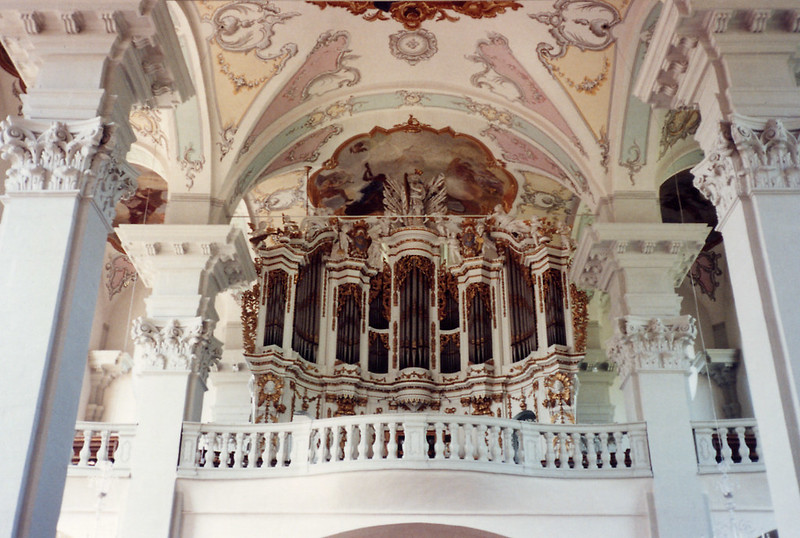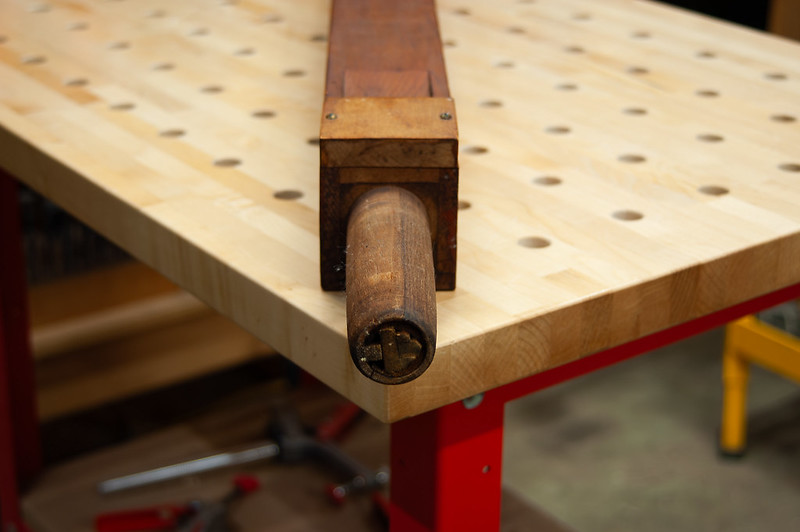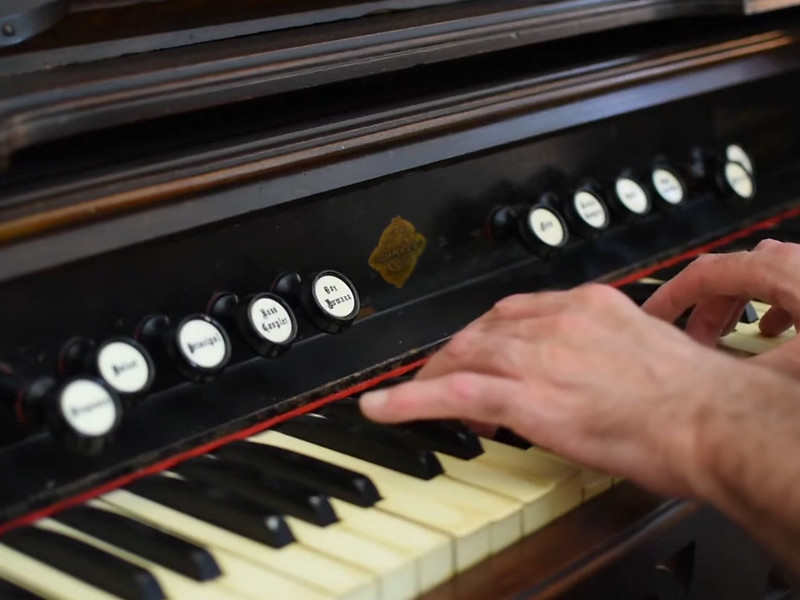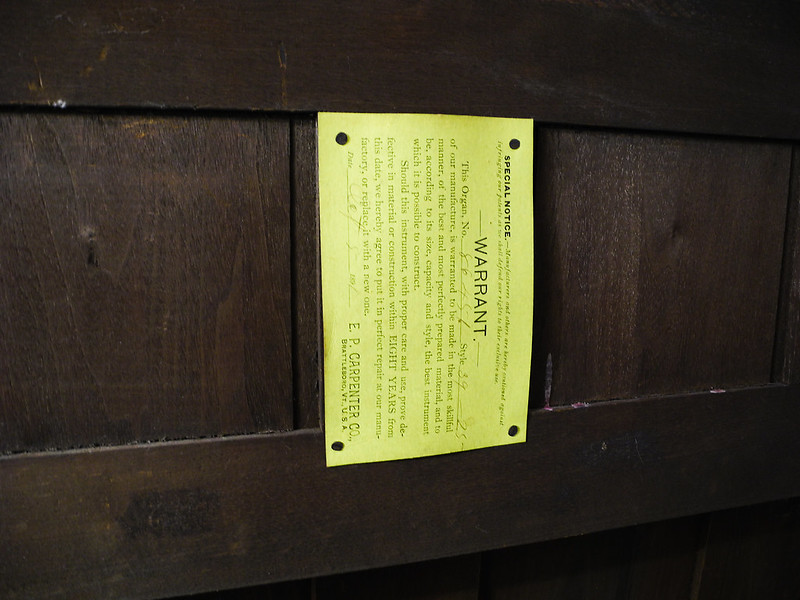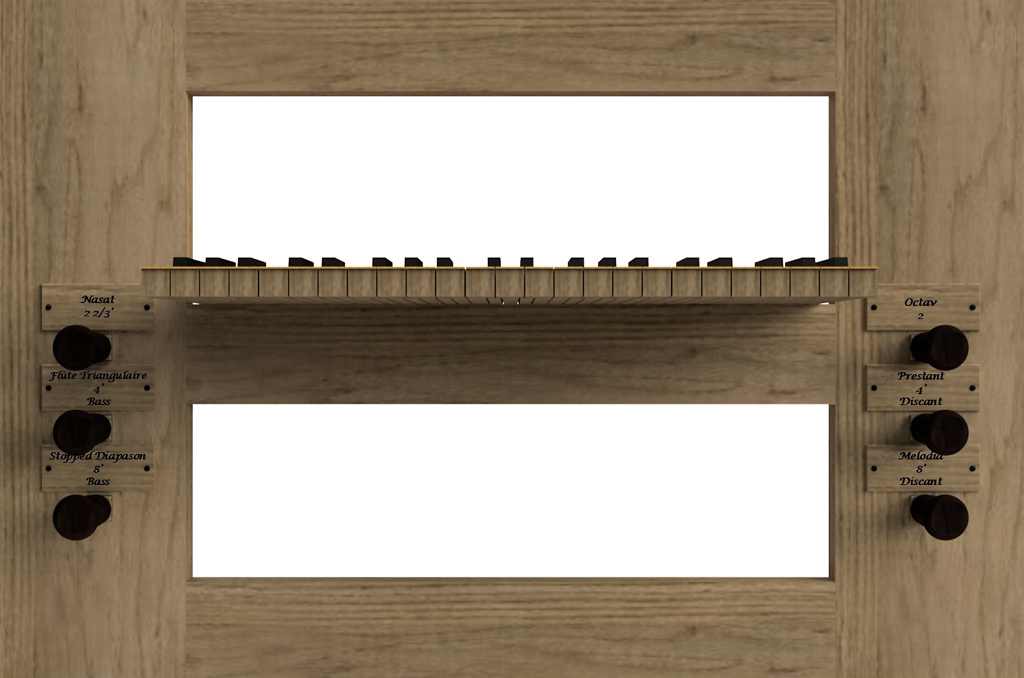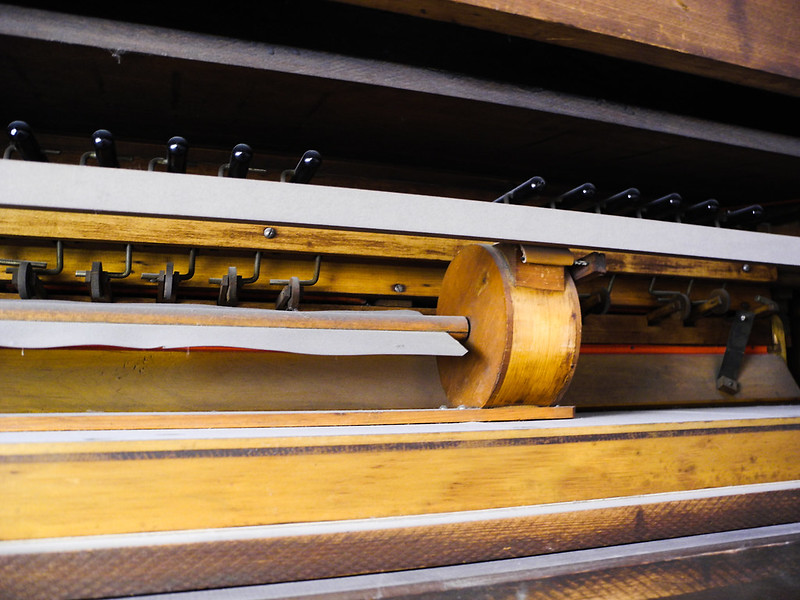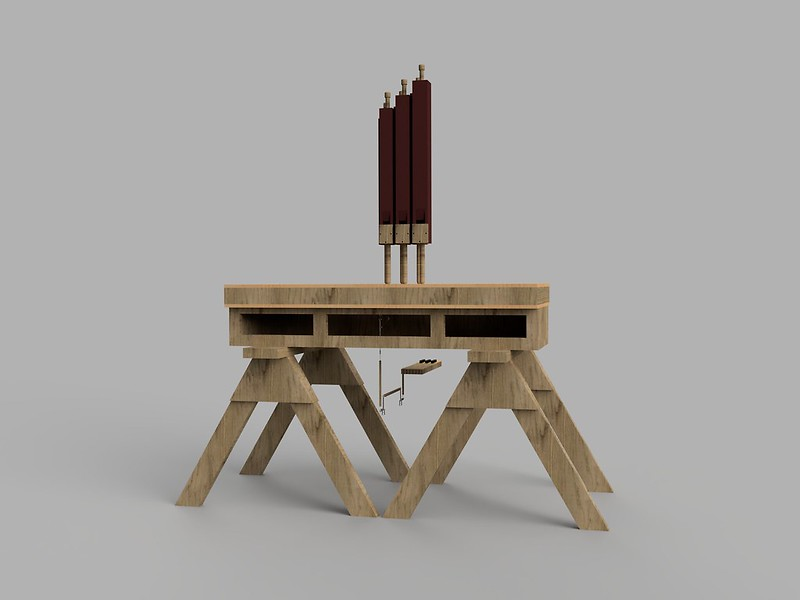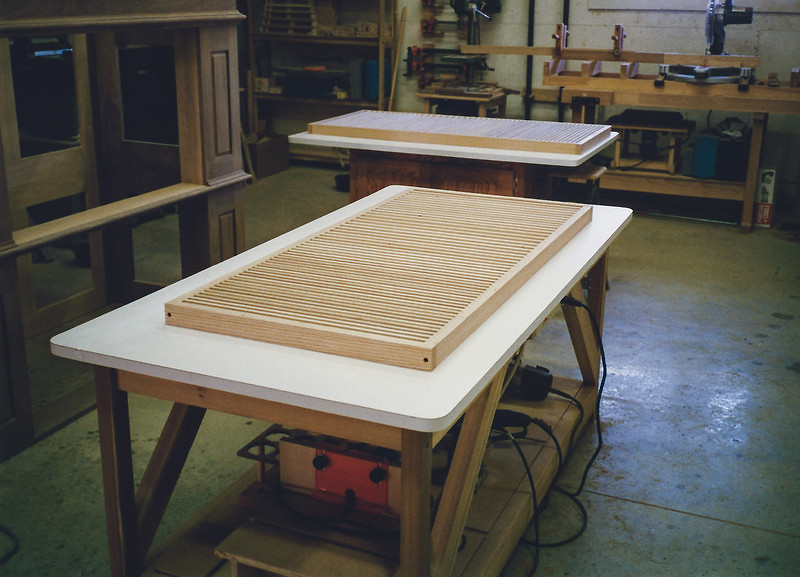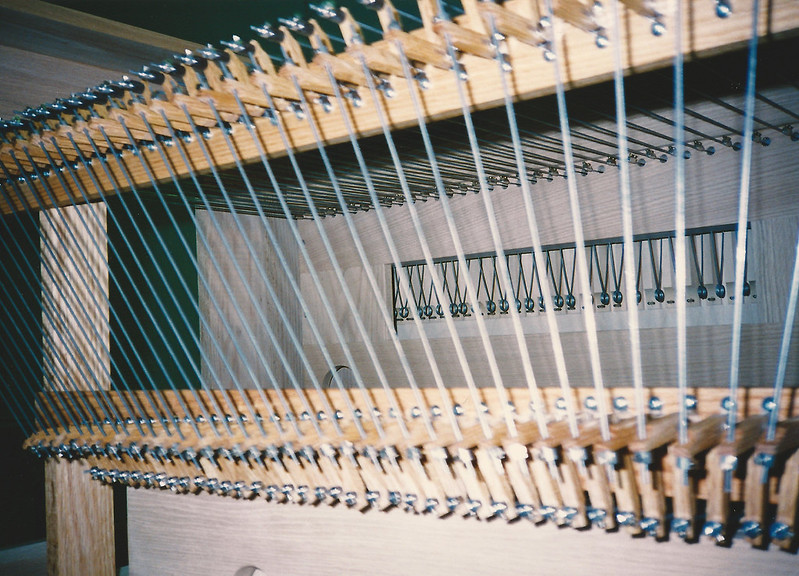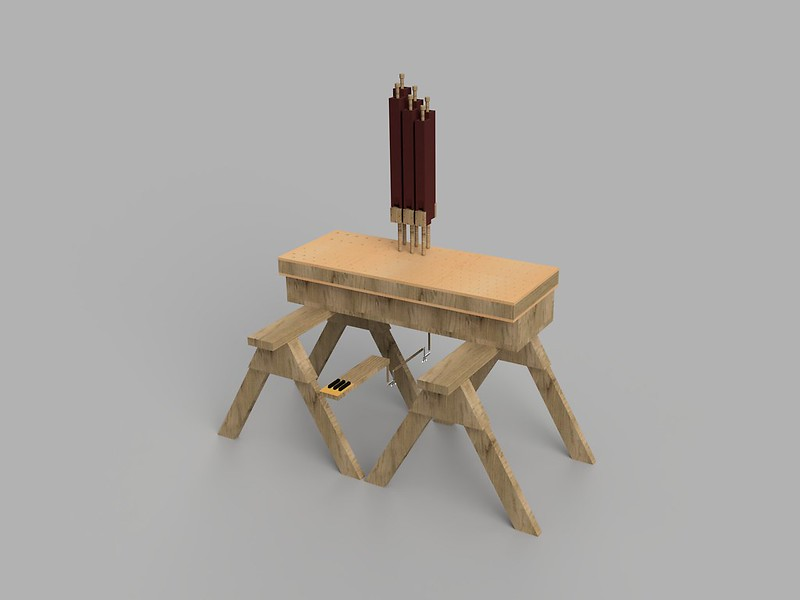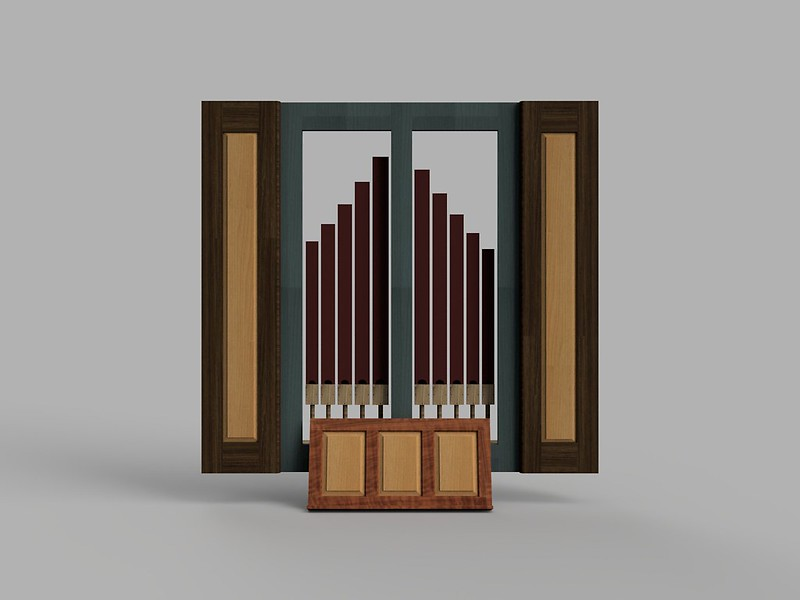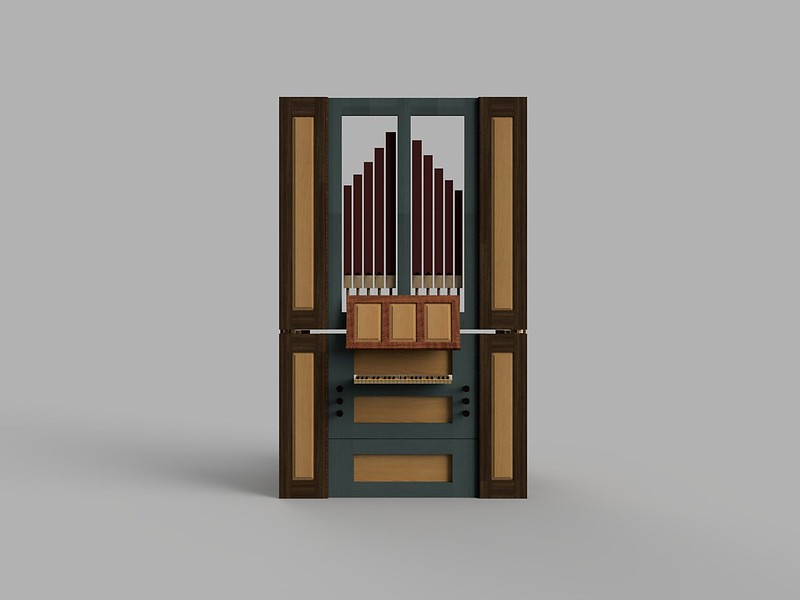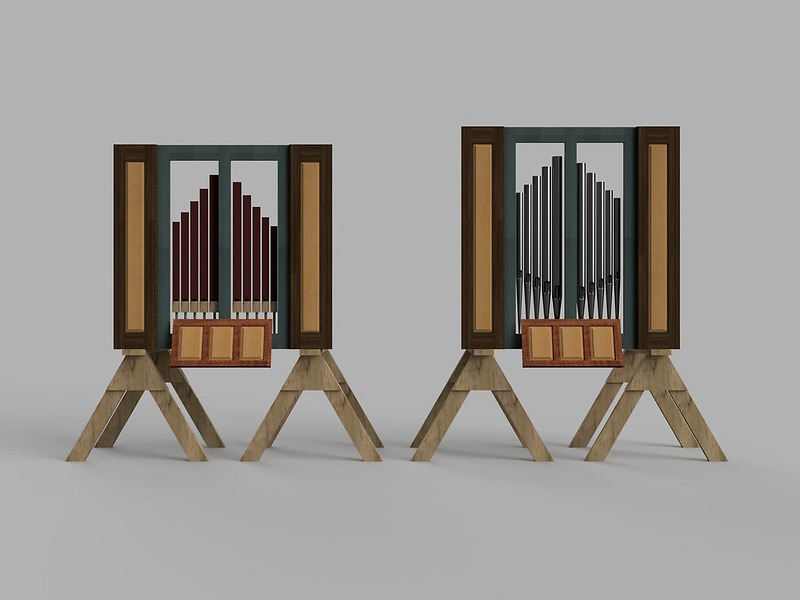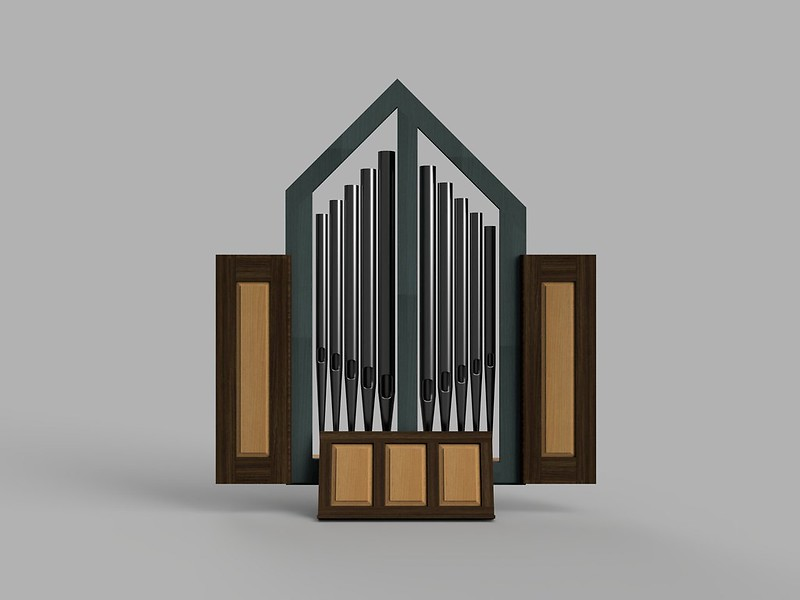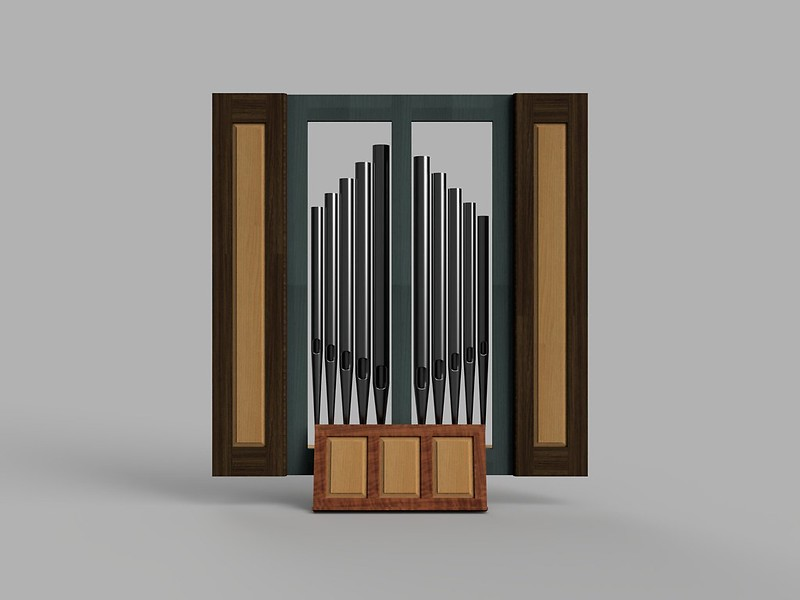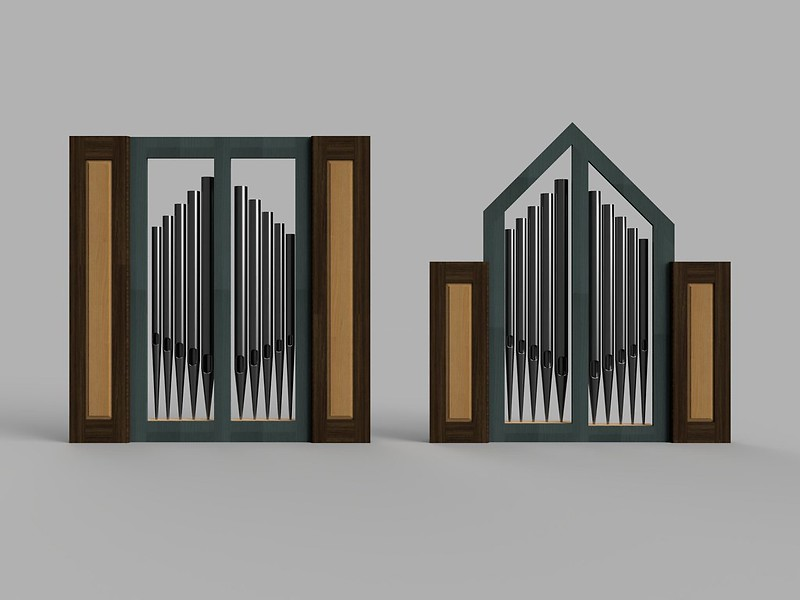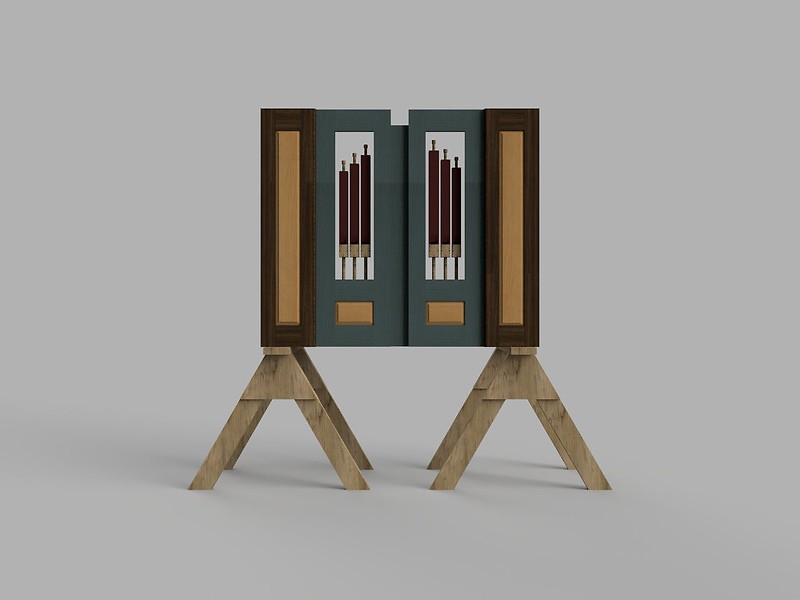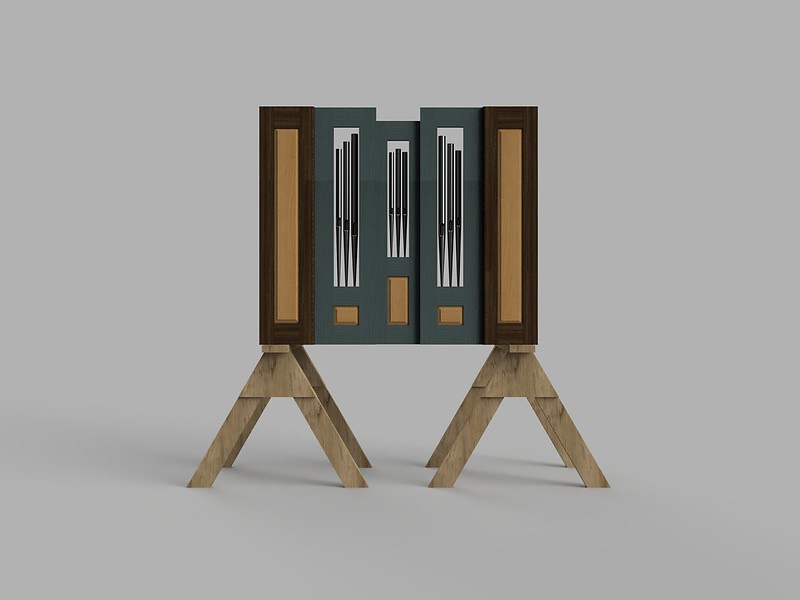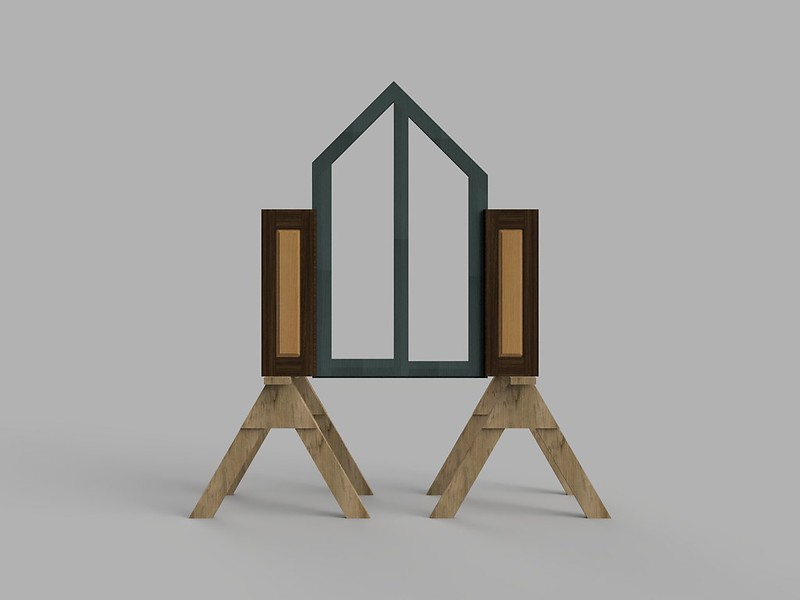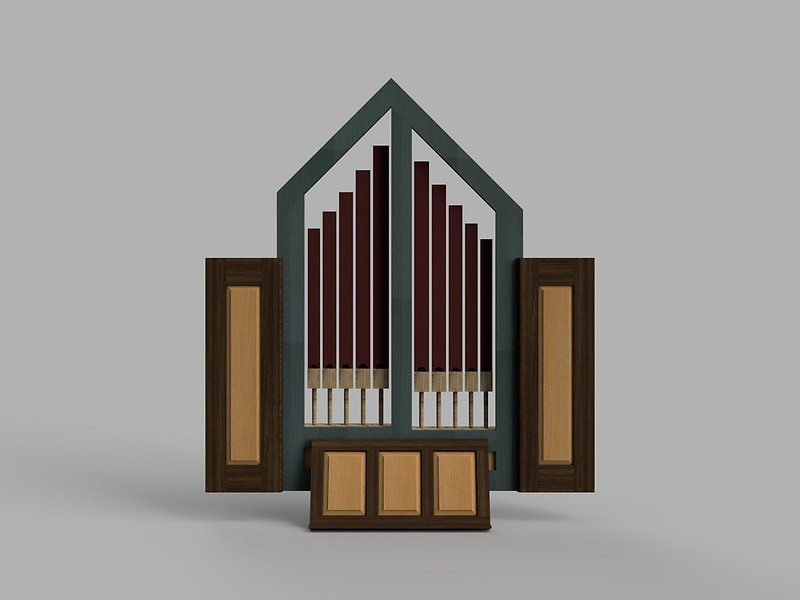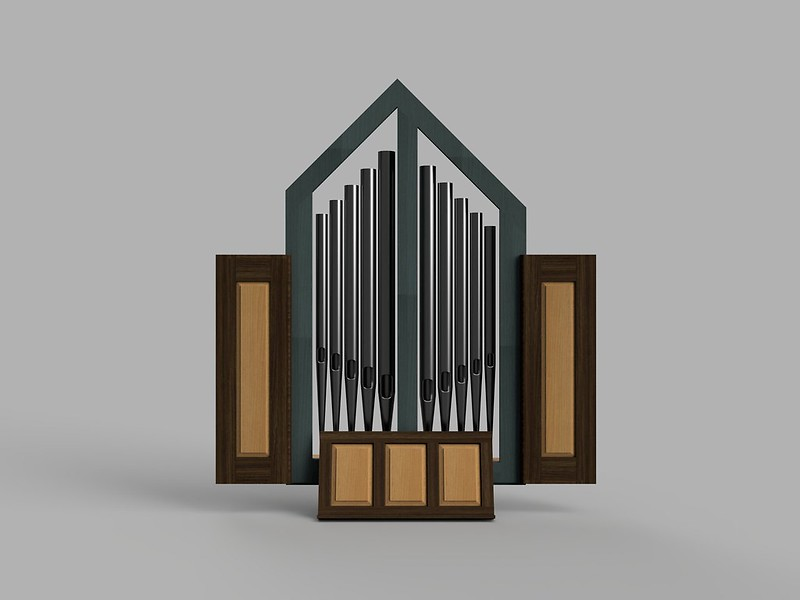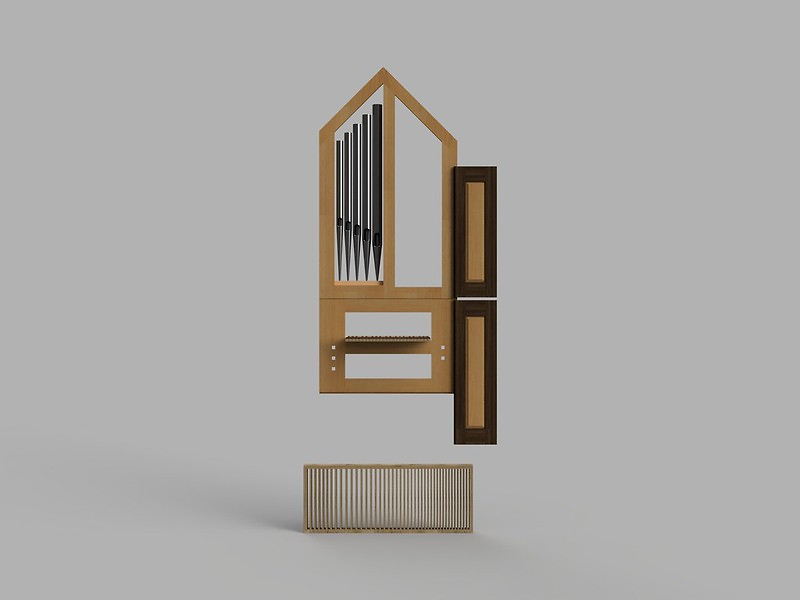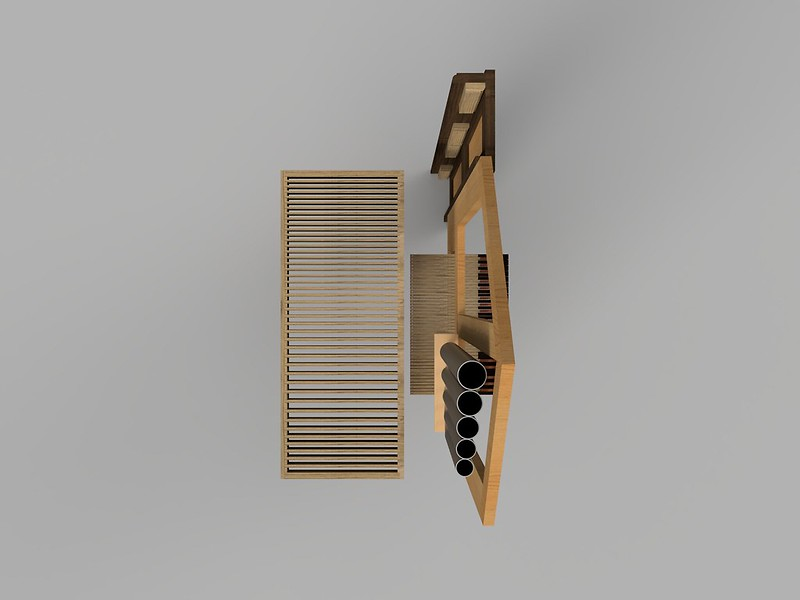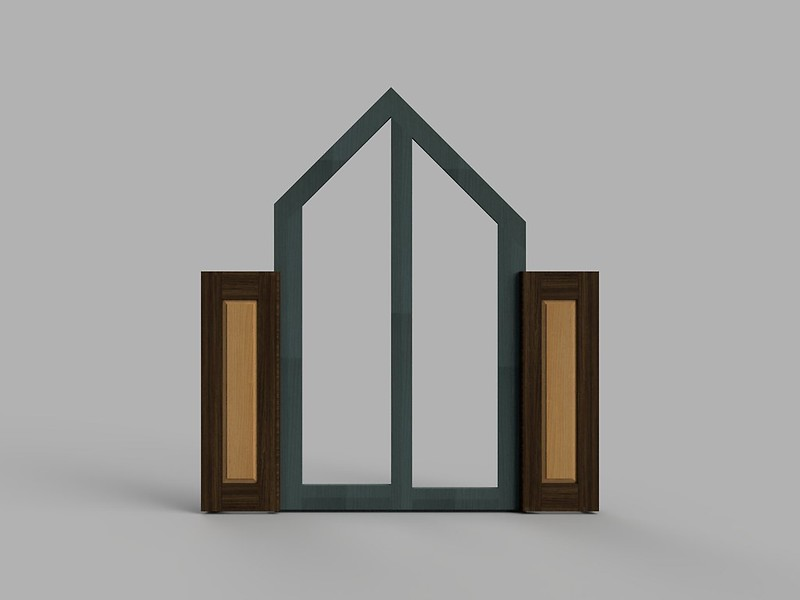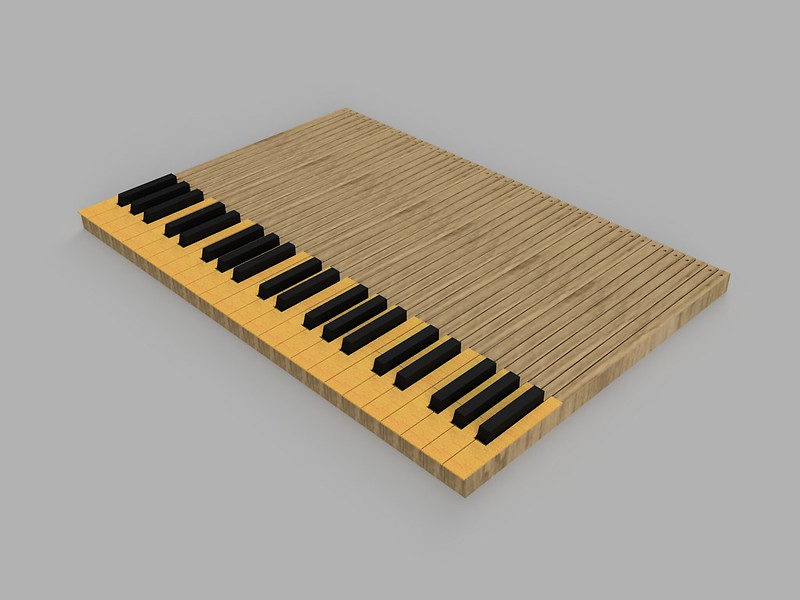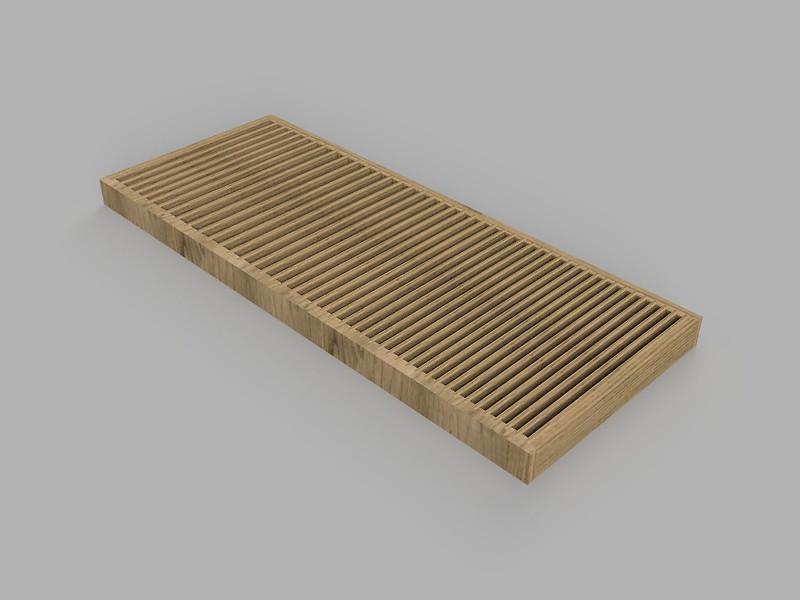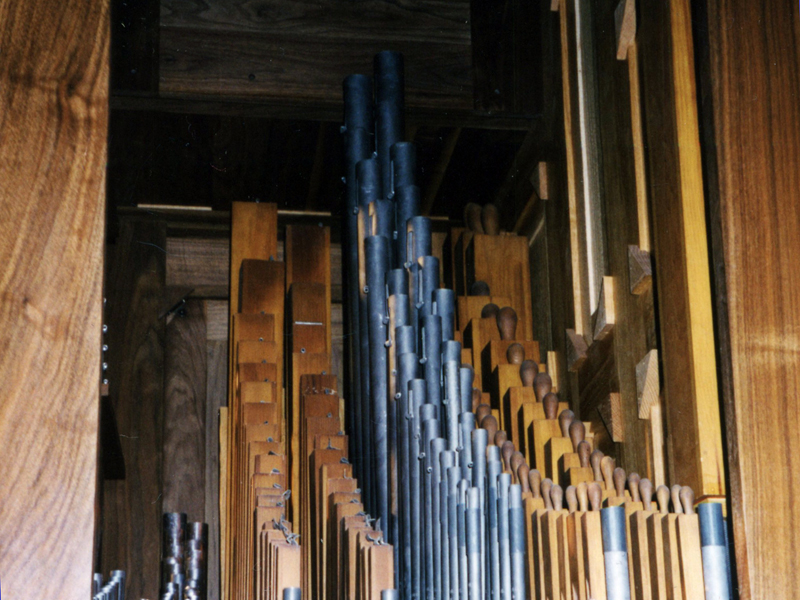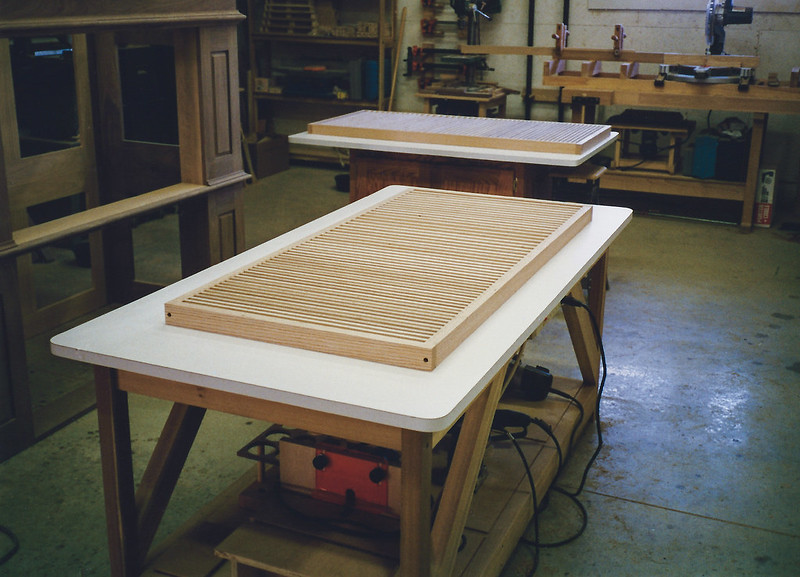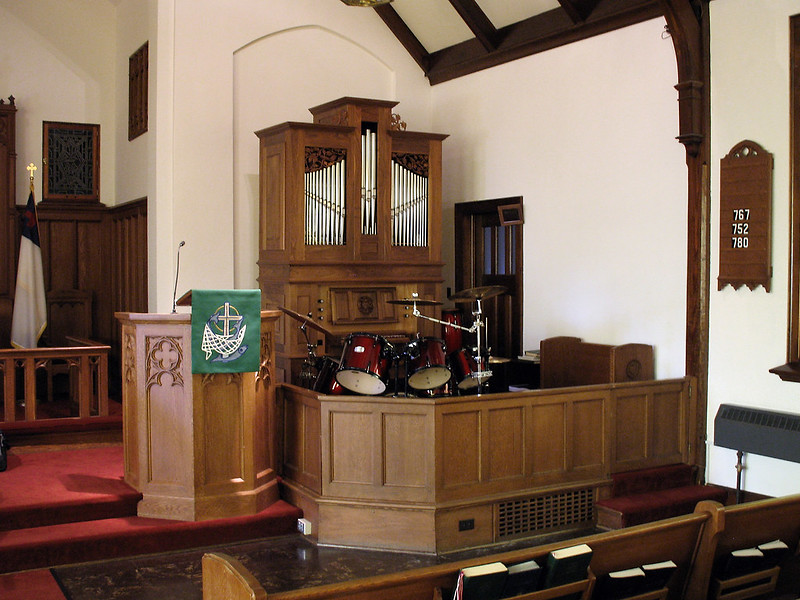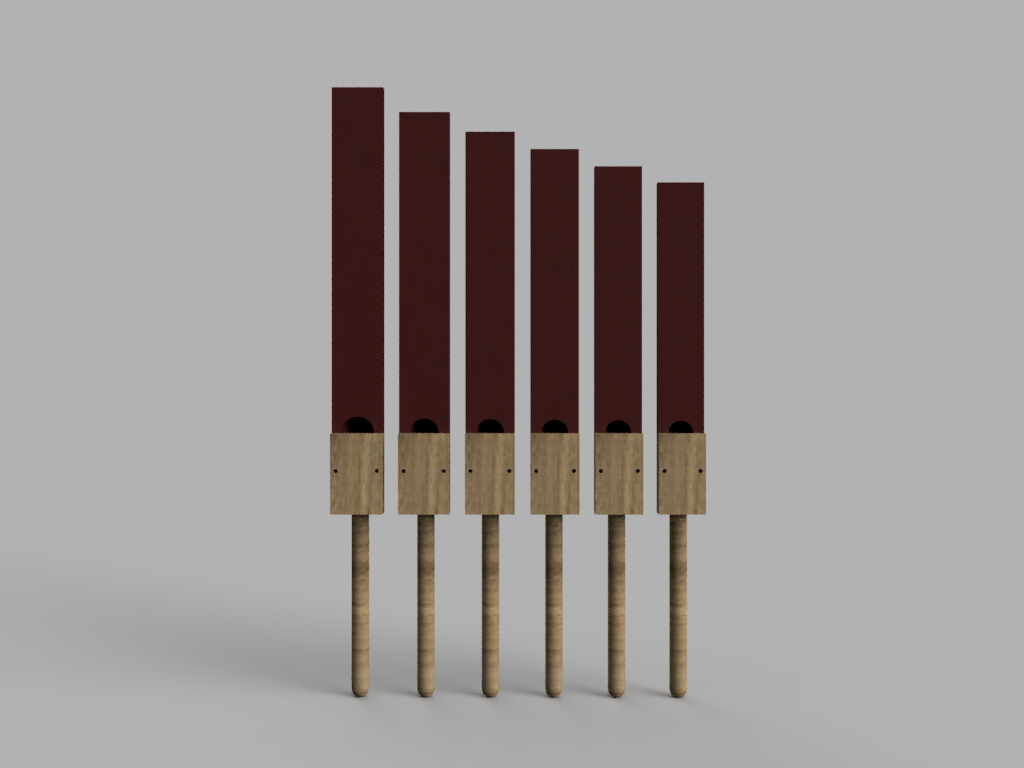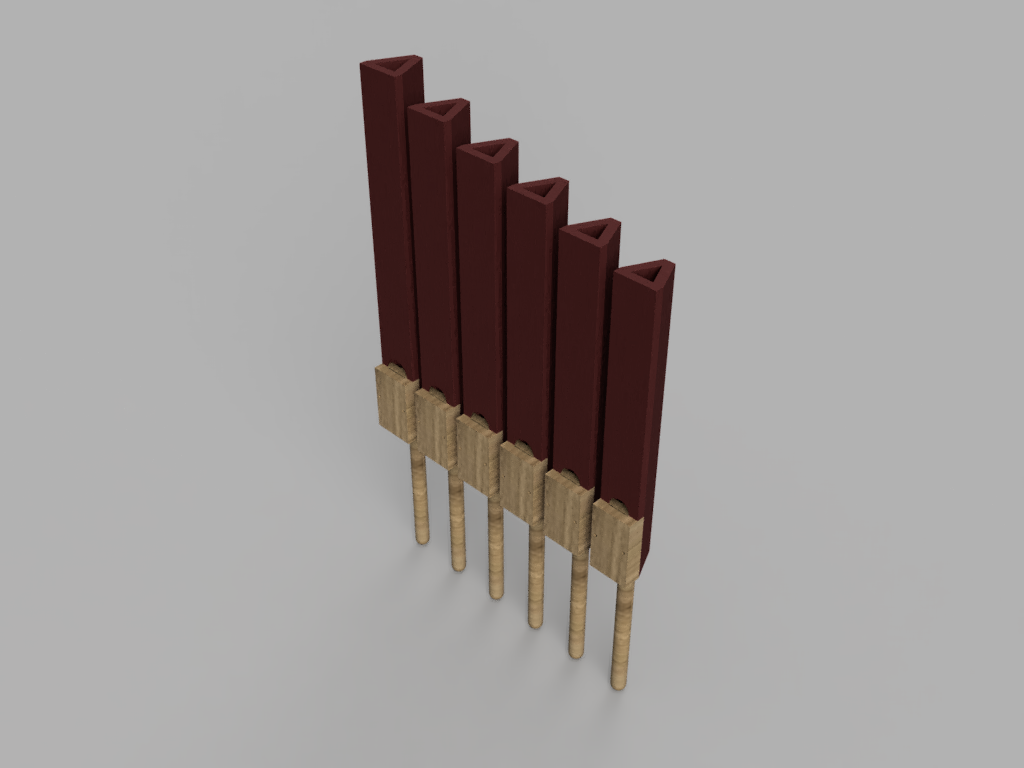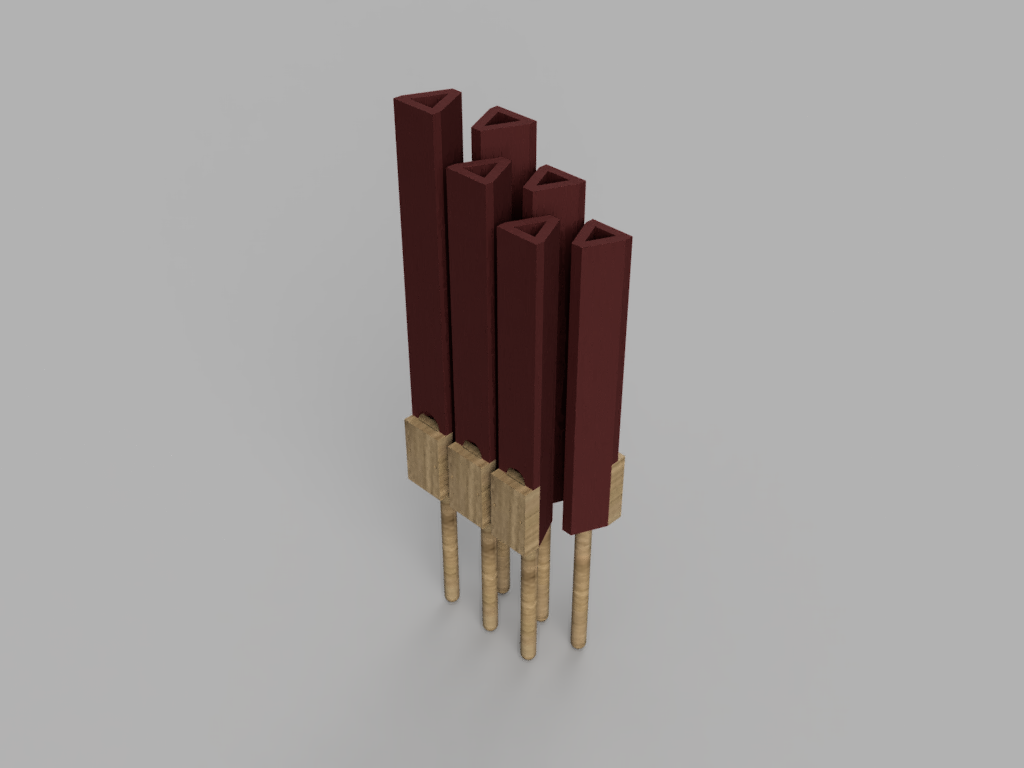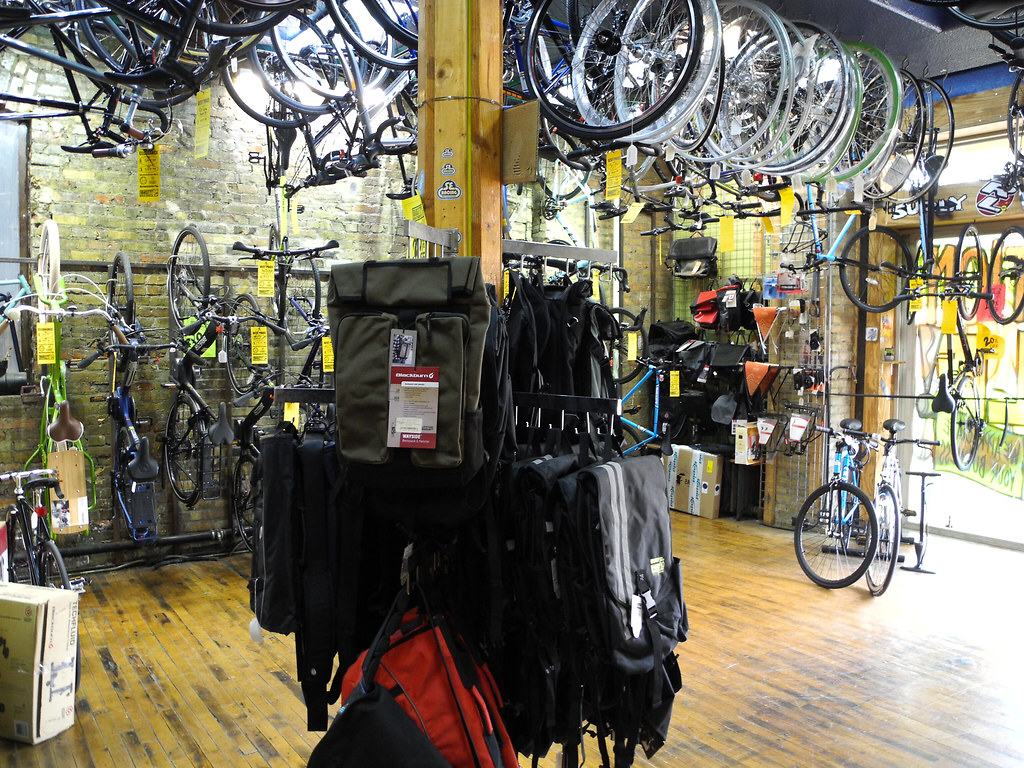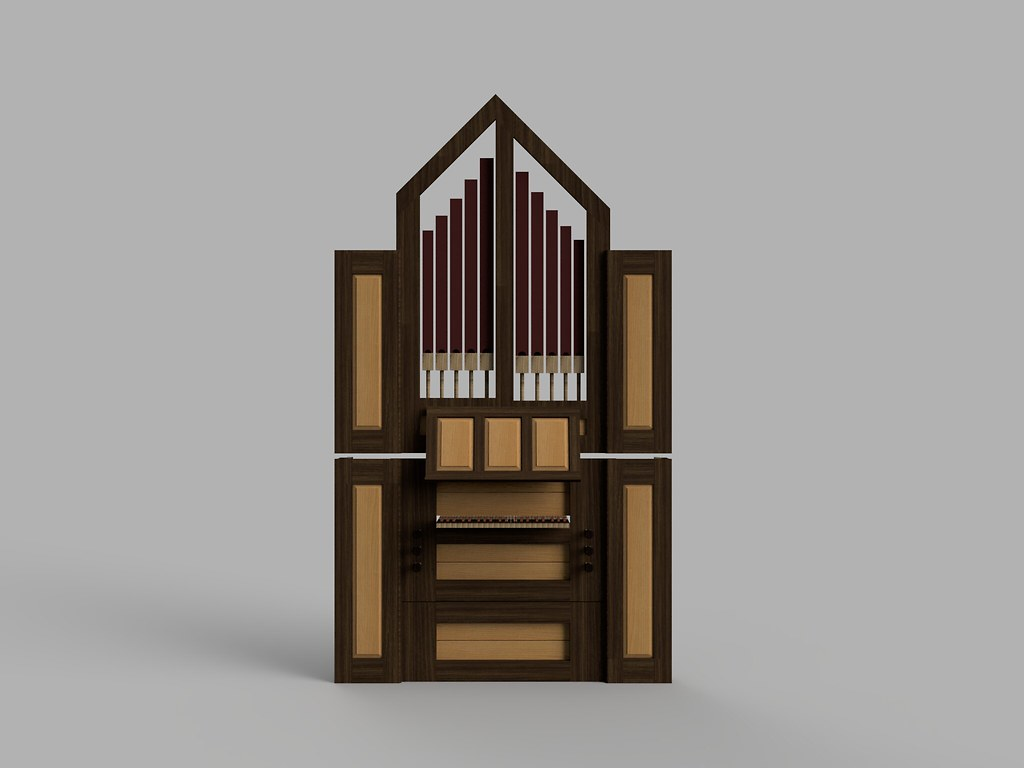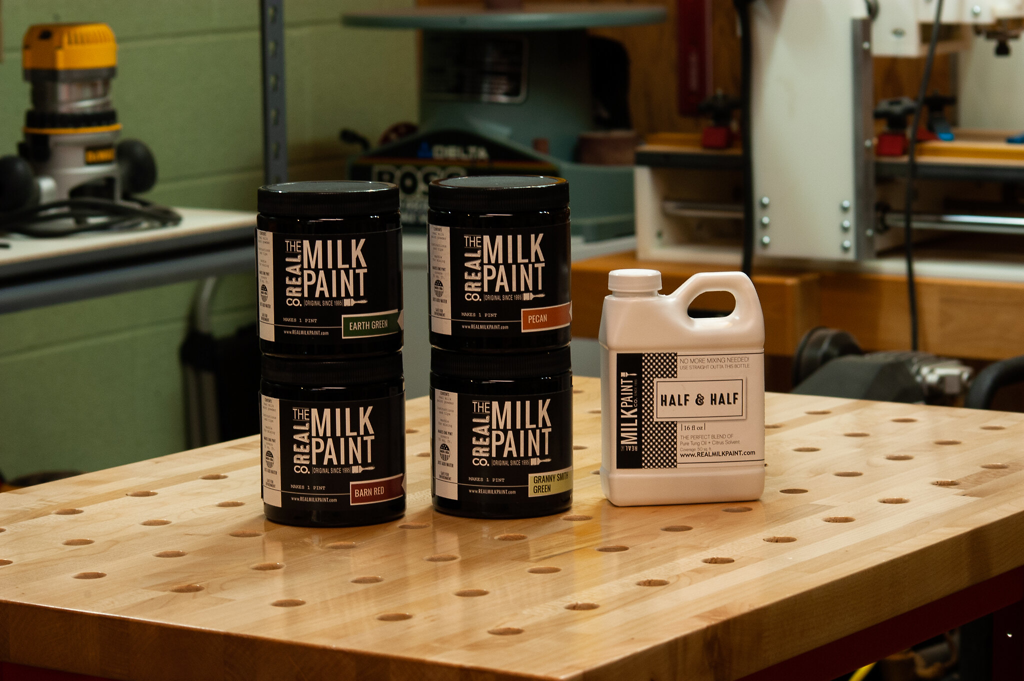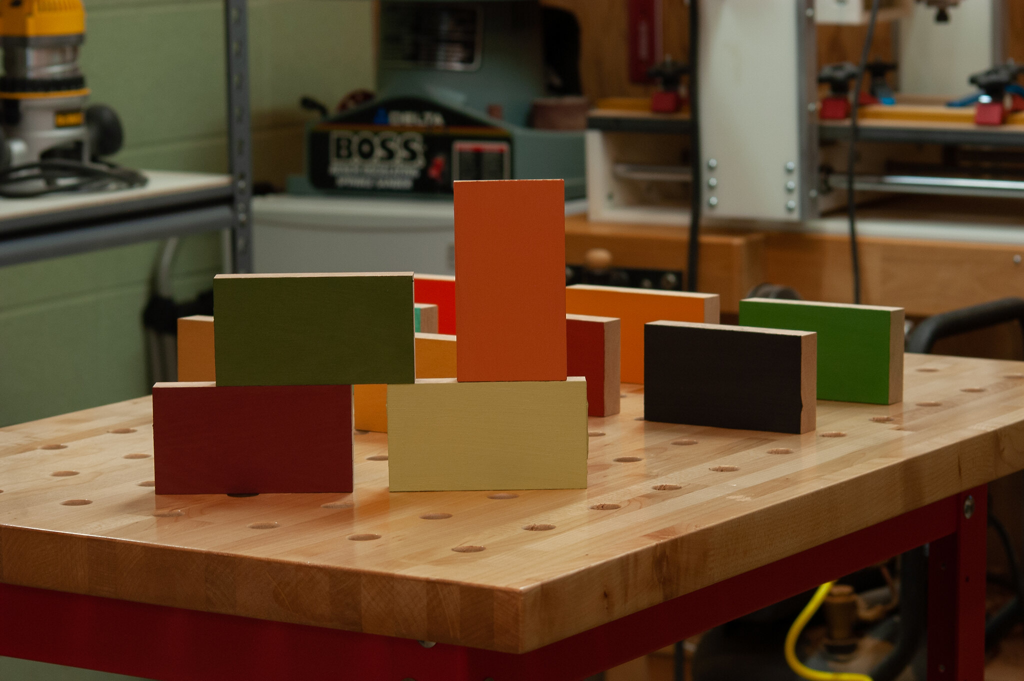![]() November 25, 2025 18:25
November 25, 2025 18:25
This is the seventeenth post in a blog where I conduct a design study focused on building a conceptual yet physically credible organ for a Minneapolis church. The study uses pipes from their existing mid-industrial era gallery organ to explore possibilities for a 43-note continuo suited to this space. I creatively draw on my familiarity with both the materials and the space, having served as an organist there for eight years.
If you are new to my project, start here and work your way up.
I introduced the concept of flexible winding in my last post. The image above is taken from the treatise "L'art du facteur d'orgues," written in the eighteenth century by the French organ builder Dom Bédos de Celles. It is still widely considered an authoritative work today. The winding system shown contains several wedge-shaped bellows, which are raised by hand and allowed to fall under gravity. Weights placed on each determine the wind pressure.
The bellows should fall at a constant velocity depending on the volume of air released from each pipe speaking. But the abrupt opening of the pipe valves as one plays the organ often induces a short pulsation in the bellows if not somehow damped. This vibration dissipates to a steady state rather quickly, but it is noticeable to the ear. In other words, an early wind system is an example of an underdamped dynamic system, one that exhibits a steady-state response along with a short initial transient response.
Stay with me here. I promise to make it easy.
A course in dynamic systems was part of my mechanical engineering curriculum while I was an undergraduate. I won't get into the math here. I won't develop equations of motion or make you solve them using differential equations that require Laplace transforms. But I want to include the graph here, attributed, showing a transient response decaying to a steady state over time. In our case, this time interval is relatively short but importantly apparent to the sound of the organ.
In addition to the graph, you can hear the transient responses generated in this audio recording I made on the first organ I built as an independent builder. The recording is one verse of the Advent hymn, "O Come, O Come, Emmanuel", ideal because the season of Advent is upon us.
The winding systems for the organs I built for two Lutheran churches that have since closed were not a series of wedge-shaped bellows. I modeled their behavior using a dynamic systems approach, creating an underdamped wind supply with a transient response that quickly decayed to a steady state response, just as some of the old organs still do.
An organ intended to play Romantic or Orchestral-Symphonic music needs steady wind, free of the transients often typical of authentic Baroque instruments, and requires an overdamped wind supply rather than an underdamped one. Steady wind is currently favored among the organ community, and I was ready to build my 43-note continuo with a steady wind supply. But lately, I see no reason to use a go-along-to-get-along approach to something that adds a beautiful dimension to the instrument's sound and the music it plays.
My innovative wind reservoir design, supplied by an electric blower, imitates the wedge bellows. It's compact and easy enough to build. I don't have to think of it as historically aligned either. It's another design element that defines my 43-note continuo.
One more thought. If you're still lost after seeing the graph and listening to the audio recording, you're not going to like the problem set I'm about to assign. Did I say, no worries? Good afternoon, class. It's due next Tuesday.
An update: Flexing wind is apparent in this recording, also made on the first organ I built, of the hymn written by Marty Haugen, "Awake, Awake, and Greet the New Morn", which is also used during Advent. The recording is an interesting interpretation of a contemporary composition played on an instrument with design roots dating to the eighteenth century. I used the Flaut 4' stop, a set of recycled open wood pipes with inverted or "German" mouths, dating from the late nineteenth century.
And it all works very well.
Posted November 25, 2025 18:25
![]() November 7, 2025 20:15
November 7, 2025 20:15
Posted November 7, 2025 20:15
![]() November 3, 2025 20:48
November 3, 2025 20:48
Posted November 3, 2025 20:48
![]() October 27, 2025 20:41
October 27, 2025 20:41
Yet once upon a time, it was an instrument that brought us together.
If you are new to my project, start here and work your way up.
The local newspaper in my hometown once ran an article about me as an organ builder when I was just starting out. A local cabinet maker framed the article for me. It still hangs on my wall. Here’s a quotation from the article.
“For Panizza, the rare organ avocation is becoming an even more unusual vocation. He recently completed and installed a pipe organ at a Lutheran church in Racine and is
building a similar model for a church in Michigan.
organs even if they are computer designed and built with a passion that is nothing
short of love.
craft that is, perhaps, no less anachronistic than the production of really good
sundials.
final battleground against mass-produced mediocrity. Yet he has a confidence that
comes from a growing public interest in all things historical, from sundials to pipe
organs.”
I like that the author of the article considered the organ an instrument of the Agrarian Age. That's how I see it, too, the instrument described in the book “English Chamber Organ: History and Development 1650-1850” by Michael Wilson, not the Industrial Age instrument discussed in the book “Organ-Stops and Their Artistic Registration” by George Ashdown Audsley.
Forget being no less anachronistic than the production of really good sundials. In previous entries, I talked about my 43-note continuo design as space-efficient, cost-effective, and a tool for building community through engagement.
Posted October 27, 2025 20:41
![]() October 19, 2025 13:38
October 19, 2025 13:38
This is the thirteenth post in a series of blog posts where I conduct a design study that conceptually builds a very real church, an organ they didn't ask for, using pipes taken from their existing mid-industrial era gallery organ. This design study provides me with the opportunity to develop, if only on paper, an example of my 43-note continuo for a space I am familiar with, using material I am familiar with. I was an organist there for eight years.
If you are new to my project, start here and work your way up.
A pragmatic church trustee wants to know why they should go ahead with this project. She didn't come out and say this exactly, but I know her well enough to know that this is probably what she is thinking. And she has a good point.
While living in La Crosse, Wisconsin, I attended and occasionally played organ, another gallery installation, for the Roncalli Newman Center located there. Their music program was entirely contemporary, so it was incumbent on me to use the organ in a way that engaged the predominantly student population. Once again, I had to employ coupler gymnastics to get enough life and energy from the instrument.
I did something else, too. I built a zimbelstern for the organ. A zimbelstern uses a rotating mechanism to sound a number of bells in succession when activated. The Carthage College organ has one. I included a historically accurate rotating star fixed to a shaft that extended out to the front of the organ case. My star was actually two stars, one large and the other smaller, superimposed on one another. I don't have a photo of the zimbelstern I built, so I modeled the star from memory in Autodesk Fusion. Associated mainly with the North German baroque organ, the zimbelstern I made set the Roncalli organ apart and really engaged the student population with its exceptional sound. It made that organ distinct and, in addition, provided a historical context.
The 43-note continuo I propose to build for yet another Catholic church associated with a place of higher learning is a chamber organ by design. By definition, the chamber organ provides opportunities for engagement. And as I found when teaching math, engagement builds community.
There are numerous ways to engage people attending church, or, for that matter, an art gallery or music performance space. The 43-note continuo is one of them, and its acquisition is a viable option for any music program wanting to build community.
Posted October 19, 2025 13:38
![]() October 12, 2025 07:34
October 12, 2025 07:34
This is the twelfth post in a series of blog posts where I conduct a design study that conceptually builds a very real church, an organ they didn't ask for, using pipes taken from their existing mid-industrial era gallery organ. This design study provides me with the opportunity to develop, if only on paper, an example of my 43-note continuo for a space I am familiar with, using material I am familiar with. I was an organist there for eight years.
If you are new to my project, start here and work your way up.
My 43-note continuo concept is at odds with some of the organ community at large. But the 43-note may be more its own instrument than I've realized until recently. Let me explain. I remember playing Mass in a small chapel when I was in college. The chapel contained a parlor organ. Outside of someone's living room, that may have been my first occasion playing a reed organ, and I did not like it. Nothing about it was familiar, no matter how much I tried to translate my experience with the pipe organ to it.
And that's where the problem was. I neither understood nor treated the reed organ as its own instrument. If I had known then what I know now, I could have made it a better experience in interpreting music on a period instrument. Organists often tell me and another colleague that my instruments need a second keyboard. And they'd really like an independent pedal with its own 16' stop. Like I did with the chapel reed organ, they miss the point.
A pianist can sit down and play my 43-note continuo with ease once they understand some simple rules of registration and get the feel for playing a sustained tone instrument. With anywhere from four to six sets of pipes, an experienced organist will immediately understand the stop list. What I'd like to see are those who understand it as its own instrument, like seeing Eddie Vedder perform "River Cross" on a pump organ during the pandemic lockdown as part of the One World: Together At Home livestream event. I want to see how others use the cost-sustainable space-efficient 43-note to interpret music and build community. Not everyone shares the same vision, though.
My 43-note continuo is not a conventional organ built along traditional lines and should not be thought of as one. I build upon tradition, but a tradition that must evolve to remain relevant.
Posted October 12, 2025 07:34
![]() September 30, 2025 18:52
September 30, 2025 18:52
This is the eleventh post published to a blog where I conduct a design study that conceptually builds a very real church here in Minneapolis, an organ they didn't ask for, using pipes taken from their existing mid-industrial era gallery organ. This design study provides me with the opportunity to develop, if only on paper, an example of my 43-note continuo for a space I am familiar with, using material I am familiar with. I was an organist there for eight years.
If you are new to my project, start here and work your way up.
As I wrote in my first post, the organ belonging to that church was an early twentieth-century industrial-era instrument with no upperwork on two manuals and pedal, not counting a mixture stop added later, though one that hardly produced a cohesive plenum. With a congregation and liturgy far removed from the symphonic-industrial era of pipe organ building, I employed coupler gymnastics to lead hymns and play improvisations. I used seven stops at most to craft a tonal design similar to the one-manual chamber organs I built as an independent builder.
When I began writing this blog project, I reached out to one of the cantors I worked with. Her name is Jayne, and she was an undergraduate music major during her time at the church. With her permission, here is what she had to say about the organ.
"Singing at St. Lawrence was my first time working with any organ, and I loved it. Organ was always one of my favorite instruments as a kid (but my parents told me I had to pick something smaller, so we did violin instead). I still love listening to organ music. I love the repertoire, how different performers play the same piece, and how every organ sounds different.
As for the organ at St. Lawrence, it was definitely my favorite. It had an intimate sort of sound that filled the space without overwhelming it. In later years, I had opportunities to sing at churches with larger organs. As impressive as they were (especially one large one in California that had a beautiful variety of stops), the St. Lawrence organ was always my favorite to sing with and the one that felt most like making chamber music."
Jayne nails it. I registered the St. Lawrence instrument as if it were one of my own, musical and straightforward. What Jayne describes in her reply advocates for my 43-note continuo, which defines a new design concept. An instrument whose sound invites, is cost-sustainable, and evolves tradition.
This post is a departure from my usual writing, where I discuss the design of a specific 43-note continuo as it evolves. Jayne's recent reply provided not only a reason to take a break, but also an affirmation that this project, if only on paper, is definitely worthwhile.
Posted September 30, 2025 18:52
![]() September 27, 2025 19:01
September 27, 2025 19:01
This is the tenth post published to a blog where I conduct a design study that conceptually builds a very real church here in Minneapolis, an organ they didn't ask for, using pipes taken from their existing mid-industrial era gallery organ. This design study provides me with the opportunity to develop, if only on paper, an example of my 43-note continuo for a space I am familiar with, using material I am familiar with. I was an organist there for eight years.
If you are new to my project, start here and work your way up.
I began using Cubify Design, a solid modeling program, in 2014 to replace 2D design. I prefer to use '2D design' rather than 'drafting' because I often employed descriptive geometry concepts. During the fall of 2015, I committed myself to modeling pipe organ key action components using Cubify Design at various coffee shops in Minneapolis.
I want to discuss this work because what I will not be showing you here are the detailed designs of the key actions employed by my 43-note continuo organ. This is not a how-to blog for do-it-yourselfers.
Just before the pandemic, I began using Autodesk Fusion, a significantly more advanced software for solids modeling. During the pandemic, I exported the key action components I had modeled in Cubify Design into Fusion. The key action models I created using either Cubify or Fusion, shown here, do not represent those I will use in the build of an actual organ. I wanted to gauge the difficulty in applying that level of detail and determine whether it was worthwhile to model an entire action.
Whether you favor historically informed mechanical action over electric action is your choice. Mechanical action provides a straightforward, reliable, and direct connection between the finger and the pipe valve. There are trade-offs, though. A delicate and light action favors the performer, but not in terms of strength and durability. Finding that balance is key. I also studied the actions of as many historic organs as possible to translate their look and feel into modern materials. The key action photo above is that of a historic German organ whose photo I included in my previous post. The photo below is of the Ducroquet.
The key action design work I did took place over the course of ten years, on and off, without me fully understanding the value that work would bring. My 43-note continuo is not a conventional design. Modeling its assemblies helps maintain a clean internal layout, where everything is well-organized and easily accessible.
Please return here periodically to view the progress of this project as I develop it. If you have a question or suggestion, please don't hesitate to contact me.
Posted September 27, 2025 19:01
![]() September 20, 2025 17:35
September 20, 2025 17:35
This past summer, I decided to conduct a design study that conceptually builds a very real church, an organ they didn't ask for, using pipes taken from their existing mid-industrial era gallery organ. In doing so, I started something that lets me use my imagination and creativity to develop, if only on paper, an example of my 43-note continuo for a space I am familiar with, using material I am familiar with. I was an organist there for eight years.
If you are new to the project, start here and work your way up.
The previous post in this series introduced the alluring idea that the tonal design of a 43-note continuo instrument could follow the split-division concept used by many of the parlor pump organs produced during the last years of this country's Frontier period. Namely, the tonal makeup of the bass can be different than, yet complement that of the treble. I offered the following specification.
Stopped Diapason 8' Bass
Melodia 8' Discant
Flûte triangulaire 4' Bass
Prestant 4' Discant
Nasat 2 2/3'
Octav 2'
In the 4' bass register, I placed a triangular flute, where some of the lowest pipes might appear in the case front. I wanted to include a triangular wood stop in this organ. I taught myself to scale, build, and voice tri-pipes after seeing a set in the Northrop Aeolian-Skinner. And since the presumptive client commissioning this organ is in proximity to the University of Minnesota, it would be a fantastic nod to my time with the Northrop organ. But after some thought, I found something more appropriate.
My small yet eclectic collection of vintage pipework had me asking questions and furnishing answers. A late nineteenth-century pipe, made of pine and marked "Cello D" in penciled script, provided the correct answer. As he was cleaning out his barn one day, Carthage College organ professor Bill Roth gave me this pipe a long time ago from his collection. A perfect companion to complement the Prestant 4' Discant, a set of bass pipes patterned on this pipe and intended to produce sounds informed by a historical period of American organ building, is easy to make if no original set is available. As an aside, I took this photo of Bill Roth with a camera I purchased to take to Europe just before my trip there, where I got to play and experience firsthand amazing instruments, some courtesy of Professor Roth and his many connections.
So, let me recast my proposed specification as follows.
Stopped Diapason 8' Bass
Melodia 8' Discant
Violoncello 4' Bass
Prestant 4' Discant
Nasat 2 2/3'
Octav 2'
The wooden Violoncello 4' Bass is an appropriate companion to the Prestant 4' Discant. It can work well, too, if some pipes are placed in the front. By introducing the Violoncello into the design of my 43-note offering, I further build on tradition, but on traditions that must evolve to remain relevant.
Posted September 20, 2025 17:35
![]() September 13, 2025 18:15
September 13, 2025 18:15
This is the eighth post published to a blog where I conduct a design study that conceptually builds a very real church, an organ they didn't ask for, using pipes taken from their existing mid-industrial era gallery organ. This design study provides me with the opportunity to develop, if only on paper, an example of my 43-note continuo for a space I am familiar with, using material I am familiar with. I was an organist there for eight years.
If you are new to my project, start here and work your way up.
During the pandemic, people were busking at home and posting their music videos online. I wanted to do the same by playing simple hymns on my reed organ, especially after seeing Eddie Vedder perform "River Cross" on a pump organ as part of the One World: Together At Home livestream event. I own a parlor organ made in 1891 by the E. P. Carpenter Company of Brattleboro, Vermont. I was unfortunately late to the party and behind on new projects, so I only posted a couple of videos. Too bad too, because the reed organ imparts an honest quality to period music as played on period-specific instruments. Hymns like "Amazing Grace" were perfect for the dark winter indoor days of the pandemic, too.
American parlor organs built during the later nineteenth century often divide their stops at tenor-f. The tonal resources offered in the bass and treble are usually different, yet they complement each other. This week, I decided to replicate that aspect of the reed organ by placing pipes in the tonal scheme of my 43-note continuo, not by traditional convention, but where I feel they belong and by utilizing them for what they do best. That way, I have timbres available where needed to create a different tonal topography than what an organist is typically used to, yet one that is fundamentally sound. Doing so opens up opportunities for crafting diversity in tonal design by using pipe set variations that would otherwise not be likely found in a small instrument.
Stopped Diapason 8' Bass
Melodia 8' Discant
Flûte triangulaire 4' Bass
Prestant 4' Discant
Nasat 2 2/3'
Octav 2'
My basic registration when playing the Carpenter is a Diapason stop in the bass and a Melodia stop in the treble. Of course, being a reed organ, there's not much difference between the two. However, the implication is that these are two distinct tonal stops. And yet, they provide the primary 8' pitch along the entire compass. My point? If the parlor organ builders did it, I can do it too.
My 43-note continuo is not a conventional organ built along traditional lines. By introducing parlor organ concepts into its design, I further build on tradition, but on tradition that must evolve to remain relevant.
Posted September 13, 2025 18:15
![]() September 6, 2025 14:33
September 6, 2025 14:33
Welcome back to the blog, where I plan to conduct a design study that conceptually builds a very real church, an organ they didn't ask for, using pipes taken from their existing mid-industrial era gallery organ. I think of the organ in terms of tradition. Tradition, though, must evolve to remain relevant. This design study provides me with the opportunity to develop, if only on paper, an example of my 43-note continuo for a space I am familiar with, using material I am familiar with. I was an organist there for eight years.
If you are new to my project, start here and work your way up. This is the seventh in that series.
At one point, I considered developing a simple mathematical formula and labeling it 'design efficiency.' Organ pipes produce the sound we hear. Everything else belonging to the organ supports them in making that sound. If we take the value of the pipes and divide it by the value of the supporting systems, we get a ratio that I call design efficiency. I want greater value placed on the sound-producing component than on the mechanisms that effect the production of that sound.
Some of the things that support the pipes making sound are:
- windchest
- key action
- stop action
- keyboard
- wind supply
Let's start with the windchest and key action. I modeled and modified the windchest from the first organ I built as an independent builder for use in my 43-note continuo design. I include design renderings, along with photos I took during the construction of my original opus list, to help you better understand what I discuss here.
My instruments use a simple mechanical key action that directly connects each key to its corresponding pipe valve. The action is reliable, tactile, and easy to regulate.
Finally, I've been placing things on sawhorses when creating design renderings. This gives me a perspective that a simple rendering of the design does not.
Posted September 6, 2025 14:33
![]() August 31, 2025 14:04
August 31, 2025 14:04
In a series of blog posts, I plan to conduct a design study that conceptually builds a very real church, an organ it didn't ask for, using pipes taken from their existing mid-industrial era gallery organ. This design study provides me with the opportunity to develop, if only on paper, an example of my 43-note continuo for a space I am familiar with, using material I am familiar with. I was an organist there for eight years. If you are new to my project, start here and work your way up. This is the sixth in that series.
A new post-pandemic course offered by the University of Minnesota College of Design, titled "Design for a Disrupted World" [CourseID: 7668], prompted me to consider what a pipe organ based solely on essential elements and utilizing recycled pipework where appropriate would look like. I incorporated recycled design elements into my approach to developing a unique 43-note continuo concept. For example, wanting a principal 4' stop in the specification led me to design an upper case frame with the lowest pipes of that stop in the front. I reused part of the front pipe layout I created for the third organ I built, as it was easy enough to do so. Not too much of a surprise, the 43-note family is based in part on the first three instruments I built as an independent builder.
What I didn't do when building the first three was to construct wood organ pipes with a triangular cross-section. I didn't develop that skill until after I started playing the Northrop organ. I have a practical reason for offering the 43-note family with wood front pipes as an alternative. Metal organ pipes are constructed of various alloys of tin and lead. They tend to bend and dent easily. Fingerprints are nearly impossible to remove. The 43-note continuo alternatives share a common base section. More on that later. But I designed the base and upper sections to be compact without sacrificing a clean internal layout that facilitates tuning and maintenance. Therefore, the pipes in front of the case are easily accessible to curious hands. This might not be a problem if the organ is located in the chapel of a church that is only used on Sunday mornings, but if the organ is located in a space with daily access, it may be wise to use wood pipes in the front. I can place doors on the case to protect the front pipes when the organ is not in use, but there are pros and cons associated with this as well. This decision will ultimately be left up to the client to make with my input.
However, this organ is being installed in the front of a church I know well, a space that sees regular daily use. Even though I will continue to design out both wood and metal front-piped alternatives, I will focus more and more on those with wood pipes in the front. Here is an alternative specification that supports the design and space.
Stopped Diapason 8' bass
Stopped Diapason 8' discant
Salicional 8' discant
Flûte triangulaire 4' bass
Principal 4' discant
Melodia 4' discant
Nasat 2 2/3'
Octav 2'
The rectangular framed metal front-piped alternative I introduced in my last post replaced the original 43-note design with an angled roof. I added the lowest pipes of an open 4' triangular stop to the new rectangular alternative, and it works out well. In fact, at just a little over eight feet tall, including the base section, the wood-piped design is five inches shorter than the alternative that uses the metal pipes from my third organ.
Posted August 31, 2025 14:04
![]() August 30, 2025 12:18
August 30, 2025 12:18
If you've been following along, you know that in a series of blog posts, I plan to conduct a design study that conceptually builds a very real church, an organ it didn't ask for, using pipes taken from their existing mid-industrial era gallery organ. This design study provides me with the opportunity to develop, if only on paper, an example of my 43-note continuo for a space I am familiar with, using material I am familiar with. I was an organist there for eight years. If you are new to my project, start here and work your way up.
My 43-note continuo design has a chromatic windchest layout. You tune the organ from its right side. The original design with an open 4' in the front has an angled roof that limits the height of the side access panel. This might be a problem for someone tuning an organ variant that contains an open 8' stop beginning at tenor-f, where access to the lowest pipes is height-limited. Throughout my time as an organ builder, I maintained and assisted in maintaining several pipe organs where access to tune, make repairs, and regulate action was restricted. This required us to take more time, which in turn cost the church more money than necessary, adding up over time.
So I redesigned the upper case for the open 4' variant, replacing the angled roof with a more conventional rectangular form. I placed metal pipes in its front, but I can just as easily put the lowest pipes of a triangular wood flute there.
Here is a specification with two 8' stops in the treble, one of which is open.
Stopped Diapason 8' bass
Stopped Diapason 8' discant
Gamba 8' discant
Principal 4' bass
Principal 4' discant
Melodia 4' discant
Mixture III
The paradoxical thing about the new alternative is that not only does it provide better tuning access, its case is about 3" shorter than the angled roof variant.
Posted August 30, 2025 12:18
![]() August 23, 2025 13:16
August 23, 2025 13:16
If you've been following along, you know that in a series of blog posts, I plan to conduct a design study that conceptually builds a very real church, an organ it didn't ask for, using pipes taken from their existing mid-industrial era gallery organ. This design study allows me the opportunity to build out, if only on paper, an example of my 43-note continuo for a space I know well, from material I know well. I was an organist there for eight years. If you are new to my project, start here and work your way up.
The designs I proposed in my previous post featured bass pipes from an open 4' stop in the front of the case. This produces a taller case that can accommodate the pipes of an open treble 8' stop beginning at tenor-f. However, the two stop lists I proposed simply had a stopped flute as the only 8' stop. I designed another case variant to take this into account. This design is smaller yet just as functional.
Stopped Diapason 8'
Flûte 4' bass
Principal 4' discant
Melodia 4' discant
Octav 2'
Quint 1 1/3'
We can place the lowest pipes of the stopped Flûte 4' bass in the front of the case if we want wood pipes there, or we can place the lowest pipes of the open Octav 2' in the front if we want metal pipes there.
The Octav 2' and Quint 1 1/3' ranks provide our resplendent upperwork. If we want more cultural inclusion, we can add a Corneta stop. Although more elaborate, this is my favorite.
Stopped Diapason 8'
Flûte 4' bass
Principal 4' discant
Melodia 4' discant
Octav 2'
Quint 1 1/3'
Corneta I-II
Posted August 23, 2025 13:16
![]() August 23, 2025 12:03
August 23, 2025 12:03
In a series of blog posts, I plan to conduct a design study, conceptually building a very real church an organ it didn't ask for, using pipes taken from their existing mid-industrial era gallery organ. This design study allows me the opportunity to build out, if only on paper, an example of my 43-note continuo for a space I know well, from material I know well. I was an organist there for eight years. If you are new to my project, start here and work your way up.
For the organ I am building, I propose the following stop list if we decide on wood pipes in the front of the case.
Stopped Diapason 8
Flûte triangulaire 4' bass
Principal 4' discant
Melodia 4' discant
Mixture III
This list proposes a break between bass and treble at tenor-f for the 4' stops, with the treble stops sharing a common bass. Each two 4' treble stops are drawn separately or together with their corresponding bass stop drawn. The bass stop is not intended to sound similar to the treble stops except where the treble stop extends it, a common practice with small instruments during the mid-nineteenth century. This Hall & Labagh chancel organ is a great example.
If we decide that metal pipes are appropriate in the front, I propose the following stop list that completes the 4' principal rank from bass to treble as the Hall & Labagh did. The 4' here is softer in tone, so its bass pipes complement the Melodia 4' treble.
Stopped Diapason 8
Principal 4' bass
Principal 4' discant
Melodia 4' discant
Mixture III
The Mixture III is there to provide a resplendent upperwork.
Every organization has value available to it in what is called latent capacity. Not every organization taps into that capacity or its value because doing so often requires structural changes that are usually difficult to grasp or implement.
Here is an example of how that applies to the 43-note continuo. Reed stops are not practical additions to the 43-note design. I can innovatively harness a trumpet or clarinet player to substitute, though. I can develop a community of musicians with their capacity to produce value. More people mean more inclusion.
In this way, the 43-note continuo invites community and inclusion.
Posted August 23, 2025 12:03
![]() August 10, 2025 11:04
August 10, 2025 11:04
I wrote here about my plan, as a design study, to conceptually build a very real church, an organ it didn't ask for, building it from pipes taken from their existing gallery organ built in the mid-industrial era. This design study allows me the opportunity to build out, if only on paper, an example of my 43-note continuo for a space I know well, from material I know well. I was an organist there for eight years. To lay some foundation, I'll be writing about organ nerd-stuff in this post, so even if the organ isn't your thing, please stay with me here.
I developed a 43-note continuo organ architecture as a post-pandemic solution to the cost and sustainability issues associated with the pipe organ, issues that prompt many churches to conclude their instrument is no longer worth continued investment.
I chose 43 notes because I found that a keyboard compass starting at F06 and continuing to B48, with a break between bass and treble at tonal-f, gave almost everything I wanted from an organ built to accompany vocal and instrumental ensembles, yet not one expected by itself to lead the whole congregation in singing hymns, the usual case with traditional workship. Because the dimensions of organ pipes increase logarithmically as one descends the scale, removing the lowest five notes and their corresponding pipes provided the design with an efficient internal layout, avoiding the awkward placement of pipes and components within the case. By doing so, I designed a well-organized internal space to facilitate tuning and maintenance.
I computer-designed my 43-note continuo from the original computer drawings I used to build my previous opus list of cabinet organs and created a scaled-back, artistically rendered design, yet one that accommodates the use of recycled organ pipes with their larger dimensions. Recycled appropriately, pipes from the late nineteenth or early twentieth century retain value in their ability to contribute timbres from eras past. When properly combined with upperwork, they provide the foundation for a diverse yet blended tonal design.
I won't say anything more about the 43-note organ because I've said it best here. Again, don't hesitate to reach out with any questions or comments.
Posted August 10, 2025 11:04
![]() August 7, 2025 19:04
August 7, 2025 19:04
Earlier this summer, I decided to stop by a church to get a photo of an organ I played for almost eight years but hadn't seen in well over that time. The organ, a gallery installation, had extensive repairs done about twenty years ago to make it playable. However, it wasn't in playing condition when I returned. I felt detached and objective as I saw the instrument again, wondering if it now seemed like a good idea in hindsight to have invested money in its renovation, or to spend further money on repairs or a substantial rebuild. It was an early twentieth-century industrial-era organ with no upperwork on two manuals and pedal, not counting a mixture stop added later, though without producing a cohesive plenum. With a congregation and liturgy far removed from the symphonic-industrial era of pipe organ construction, I employed coupler gymnastics to lead hymns and play improvisations. I had to shake my head at that.
Two years ago, I developed my post-pandemic 43-note continuo concept, one that evolves tradition by recycling old pipework with new to produce a blended, culturally eclectic tonal design, an instrument both cost-sustainable and space-efficient. And by adding a mobile platform, the 43-note became, to some degree, location agnostic. I discuss it in more detail here, asking the reader to consider the organ in the context of a tradition that must evolve to remain relevant.
Well, I got an idea in my head. What if the church I reference here opted to commission a new 43-note frontal organ built from three or four ranks of pipes recycled from their upstairs organ, while adding some upperwork to make the organ more tonally versatile? I drew up the following specification.
Stopped Diapason 8' bass
Stopped Diapason 8' discant
Gamba 8' discant
Flûte triangulaire 4' bass
Principal 4' discant
Melodia 4' discant
Mixture III
If you read the next post down, you'll see that I've essentially done this before.
With that, I plan to conceptually build the church an organ it didn't ask for as a design study, allowing me the opportunity to build out, if only on paper, an example of my 43-note continuo for a space I know well, from material I know well. I have the design tools I need and have already completed much of the work. I only need to translate and modify that work to a new specific use case.
Please come back here from time to time to see progress on this assignment as I build it out. If you have a question or suggestion, feel free to contact me.
Posted August 7, 2025 19:04
![]() August 4, 2025 19:49
August 4, 2025 19:49
My workshop is located in a building that is part of the Northeast Minneapolis Arts Association. Each spring, NEMAA hosts an open studio art tour known as Art-A-Whirl. The largest concentration of activity is found at the Northrup King Building. It struck me during an Art-A-Whirl at the Northrup King Building how many artists reuse old material in their new work. That led me to reflect on the first organ I built as an independent pipe organ builder.
The organ came about when I was asked if I would be interested in what was left of an early twentieth-century pipe organ that was removed from a church in northern Illinois and stored in a basement. What I found worthwhile in that material was three sets of pipes that could be used to make a late-baroque cabinet organ if revoiced and added to by new pipe ranks that would provide the new organ with a complete and well-rounded set of tonal resources.
I set about designing a one-manual mechanical action cabinet organ built around a specification that included the three older sets of pipes along with two new sets that completed a unified tonal plenum based on the late baroque style common to southern German organ building of that period. The new organ design included a new slider windchest, new wind supply, new casework of solid walnut, and a new mechanical action to directly connect each key to its corresponding pipe valve, all produced by me in my workshop.
I contracted out the keyboard and metal pipes to respective firms, who did work in reproducing early organ material to stay true to the historical nature of the instrument. Carvings were done by a local artisan whose regular business was furniture refinishing.
I would not have built an organ using older material had it not been available for free. However, organs have been built this way for centuries. Obviously, though, many artisans use older artifacts in their work, basing much of it on the principle of reuse and repurposing.
Posted August 4, 2025 19:49
![]() August 4, 2025 18:21
August 4, 2025 18:21
I solids modeled the triangular organ pipes shown here in Barn Red, another milk paint color offered by the Real Milk Paint Company. Earlier this year, I saw pipe organ restoration work associated with a mid-nineteenth-century instrument posted on social media when milk paint was making the social media rounds through posts by woodworkers building things like period-correct Windsor chairs.
Some of the internal organ assemblies and larger wood pipes under restoration were painted darker red. I thought about painting the larger pipes I hang off the back of an organ case with red milk paint. There began my passion for milk paint.
I first learned to build tri-pipes about three years ago after seeing a set belonging to the Northrop organ. Building taught me much about them. I would accidentally discover a harmonic variant before considering how an early-twentieth-century pipe shop might have determined scales for an entire set. The practical use of hemispherical mouth geometry was another find, but one that requires later discussion in somewhat greater depth.
The tri-pipe construction seems to have no real tonal benefit. Their main advantage is that they nest efficiently and in doing so free up toeboard space for additional ranks where space is at a premium.
Posted August 4, 2025 18:21
![]() August 27, 2022 11:06
August 27, 2022 11:06
Youngblood Lumber, which suddenly closed after serving the area for generations, was a major source of hardwood lumber to the artisan community in Minneapolis. Another independent business important to me also closed just prior to the pandemic. I was interviewed for an article that appeared in the campus newspaper. You can read it here.
Youngblood Lumber's closing is important to me as an organ builder. It might not be so obvious why closing an independently owned bike shop is equally important unless you read the article linked above. We in the organ community know that the pipe organ has had its own sustainability issue for some time. My experience with the 1802 Tannenberg organ at Hebron Lutheran Church in Madison, Virginia, let me see an approach to sustainable design through the work of a builder living through the constraints of frontier colonial America. I believe the work of Tannenberg is applicable to my work today.
Posted August 27, 2022 11:06
Reuse and Recycle: The Story of a 43-Note Build
by Steve Panizza
Recent Blog Entries
- An Engineering Approach to the Historically Underdamped Nature of Flexing Wind
- Flexible Winding
- Katherine and the Concept of Latent Capacity
- An Agrarian Age Instrument, The Organ is a Bad Idea
- Creating an Opportunity for Engagement
Archive
